








by Ian Anderson, Chief Executive
We’ve never been the type to polish up a glossy corporate brochure, because Iceni has always been about the people and the stories that make us who we are.
When I started Iceni, I couldn’t have imagined the tribe we’d build, or that one day it would be as much theirs as mine. This year that really hit home: I found myself pedalling to MIPIM in some sort of self-inflicted penance, while our Managing Director, Kerry, and the others shouldered the very real work of steering us through the final stages of our change in ownership. That moment summed it up; what began as my challenge is now shared, owned and carried forward by all of us.
Our 20th year has been full of highs, but also marked by deep loss. The sudden passing of Jennine Romeo - at the time, my Executive Assistant, and one of Iceni’s stalwarts - still feels raw. She would absolutely hate that we’ve put her on the cover, but she also deserves nothing less. Jennine’s presence, humour and grit will remain part of Iceni’s story forever.
So here’s to another year of staying different.
To the projects, the places, the people.
And most of all, to Jennine. Long live her memory.

by Olivia Buchanan, HR Manager

This year has been an extra special one for Iceni. As we celebrate 20 years of the business, it is a powerful reminder that our success has always been rooted in our people - their energy, talent, and passion. Over two decades we have grown, adapted, and achieved so much - and at the heart of it all has been the Tribe. This year in particular has shown not only what we can achieve together, but also who we are as a community.
One of the most significant milestones in our 20th year was Iceni’s transition to an Employee Ownership Trust. While in many respects this was a structural change, it also spoke directly to our culture and values. Ownership now rests with all of us, recognising that Iceni’s true value has always been created by its people.
In many ways, becoming employee-owned has simply formalised what was already at the heart of Iceni - a culture built on collaboration, pride, and shared
responsibility. We are different in structure, but our essence remains the same. What has carried us hereour spirit of openness, entrepreneurialism, and care for one another - is the same foundation that will carry us forward.
The move to employee ownership builds on our legacy and strengthens our future: a business shaped and sustained by the people who make it thrive every day. We are staying different - in how we are owned, in how we work together, and in how we continue to grow without losing what makes Iceni unique.
We’ve welcomed 54 new colleagues into the business during the last twelve months - from graduates taking their first steps into the built environment, to experienced leaders and technical experts in their fields bringing fresh perspectives and valuable expertise.
But this expansion is not just about numbers; it reflects the strength of our culture and our shared commitment
to Iceni’s future. Today, 41% of our workforce is male and 59% female, a balance that demonstrates encouraging progress towards inclusivity and representation.
Lucy Barton-Roberts became the 100th female employee in Iceni Projects, after she joined the business last month. She joined Iceni after a career of almost 20 years at the RTPI, to take the newly created role of New Business Manager in the company’s Business Development team.
As we continue to grow, we remain focused on nurturing a workplace where every colleague feels a true sense of ownership, belonging, and pride in what we achieve together.
Learning and development have remained central to Iceni’s culture, with colleagues across the business actively engaging in training and workshops. A highlight was our bespoke Leadership Programme delivered by Victoria Hill at Promind, designed to equip our future leaders with the skills and confidence to thrive.
Equally important has been our uniquely Iceni approach to knowledge-sharing - from lunchtime CPDs and Iceni Academy introductions to crossteam sessions that bring people and ideas together and knowledge-sharing sessions with key clients. Development at Iceni is not only about formal training, but about sustaining a culture where everyone can learn, share, and grow together.
As we mark 20 years, our ambition has been to make sure every colleague feels part of the next chapter. Equality, diversity and inclusion have remained a priority, through networks, awareness sessions, and partnerships with the community and universities to broaden access to our profession. More than policies or programmes, it is about building daily habits that ensure all voices are heard, opportunities are shared, and colleagues feel a genuine sense of belonging.
Supporting wellbeing has also been a cornerstone of our work. We’ve continued to build on flexible working
practices, expand our wellbeing resources, and open up conversations around mental and physical health. Uptake of these initiatives continues to grow, showing their impact.
We’ve also seen a bigger uptake this year in our Octopus Electric Vehicles scheme, with more colleagues signing up to greener and more sustainable commuting options.
A 20th anniversary is a time to celebrate – and we’ve done just that. From promotions and professional achievements to project successes and personal milestones, we have taken time to recognise the people who make Iceni what it is. Our trip to Tuscany in June was testament to this - what a weekend!
Beyond work, we’ve connected through our Give a Day, Get a Day programme, contributing hours to causes close to our hearts, and through social moments – from charity challenges to away days. These experiences have reminded us that shared joy is just as important as shared responsibility.
As we look to the next 20 years, our focus is clear: to keep investing in our people - in their growth, wellbeing, and in building a culture of belonging. Employee ownership has placed our future firmly in our collective hands, and it is a future we will shape together.
The certainty and security that we can offer new employees as an employee-owned business, combined with our strong culture and values, will continue to make us an appealing employer for new people, helping us to secure growth, profitability and a sustainable business well into the future.
If this milestone year has shown us anything, it is that Iceni’s greatest strength lies not only in what we do, but in the people who do it. That is, and always will be, the Iceni way. We are staying different.
by Hannah Sally, Assistant Planner, Planning (Glasgow)

Fresh from a four day, 290 mile cycle from London to Leeds, the Iceni Tribe arrived at UKREiiF energised and ready for a week of action. This year’s cycle was particularly special, jointly marking Iceni’s 20th anniversary and the Mac Mic centenary.
Alongside our Mac Mic colleagues, Iceni was represented by a diverse team of professionals from across the regions, including Chief Executive, Ian Anderson; Chief Operating Officer, Andrew Gale; Head of English Regions and Wales, Danny Collins; Planning Directors Lorna O’Carroll, John Mumby, and Ian Mayhead; Planning Associate Director, Ashleigh Bullough; Engagement Director, Gemma Gallant; Transport Director Clive Burbridge; and myselfrepresenting the under-25 cohort.

With a packed programme of presentations, roundtables, and panel discussions, the Tribe were engaged in a range of topics including the future of data centres, alternative residential, retrofit and reuse, new towns and the growing role of AI within the industry. Beyond the formal sessions, fringe events were well attended, allowing targeted networking with developers, local authorities, politicians, and consultants within the industry across the regions.
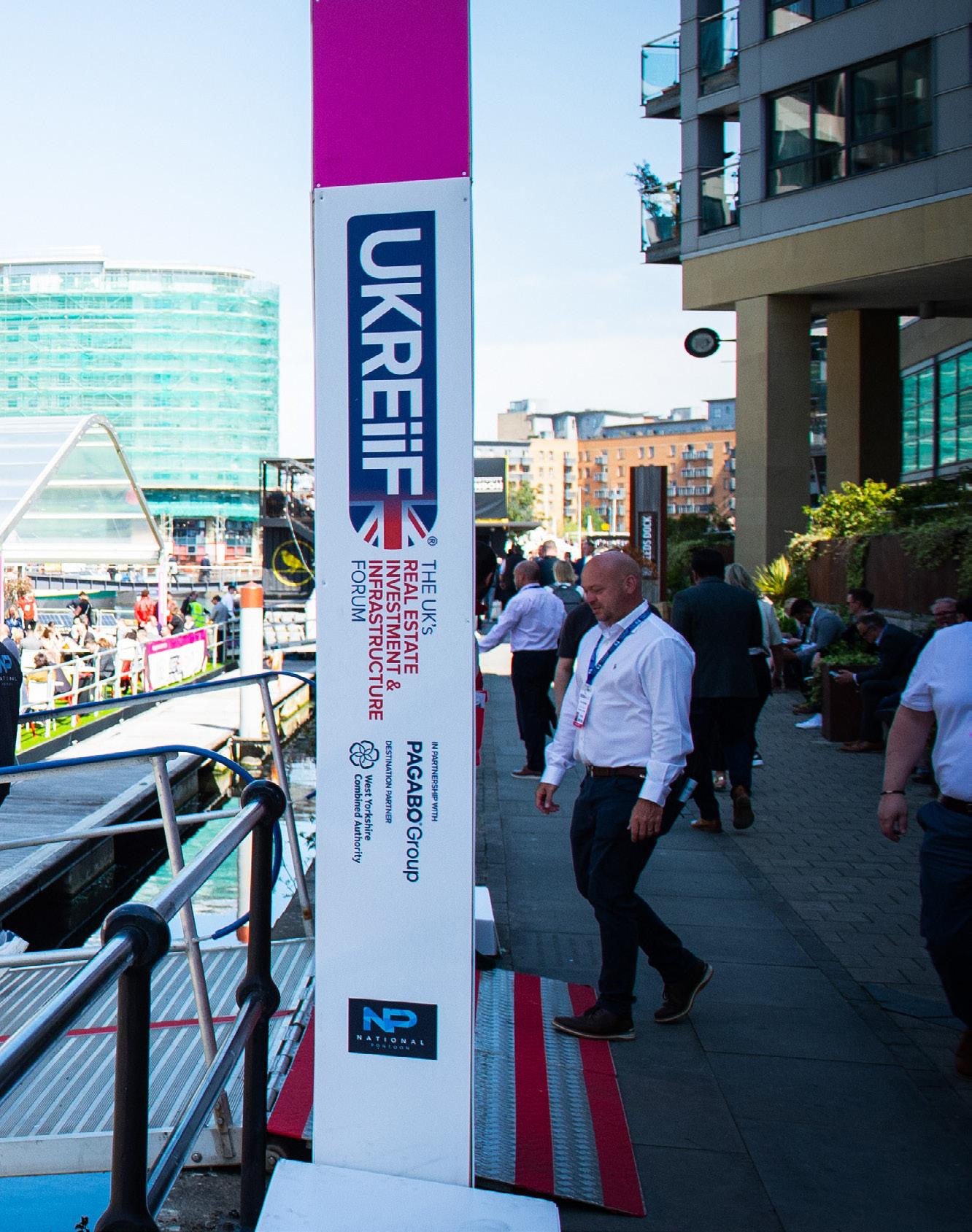
A shared consensus emerged among public and private sector stakeholders around key priorities such as economic development and sustainable growth, coupled with a recognised need for strategic planning in response to shifting market conditions and an evolving political and economic landscape.
UKREiiF offered a valuable platform for industrywide engagement alongside targeted opportunities for young professionals to expand their networks through next-generation events, sessions with sector leaders, and shared insights and advice from industry professionals. A favourite event was the Iceni Curry Night, where almost 50 professionals across property and development firms came together for a relaxed evening of great food and conversation.
Looking ahead, we have already secured delegate passes for UKREiiF 2026 and are looking forward to continued engagement with sector leaders whilst fostering multidisciplinary collaboration and empowering the industry’s next generation.
by Sophie Innes, Associate, Strategic Planning

In March, a number of colleagues across strategic planning, design and transport went down to Southend-on-Sea for the day and - rather than get the bucket and spade out - we spent the day volunteering at the St Vincent’s Centre. This charity has a centre in the city which provides a community space where vulnerable local people are supported through a range of different services and activities.
The day saw us getting stuck into a range of different tasks including sorting donations of clothes and food, helping with cooking lessons and collecting furniture. We also learnt about the charity’s different initiatives, from using 3D printers to create different games and toys to sell at their market stools, to their ‘Hungry Cupboard’ project which seeks to encourage food donations and raise awareness of poverty in local schools.
It was a rewarding day and great to do more in the area beyond the day job!
by Ben Gurney, Associate, Landscape

Since the last Yearbook was published, we have continued to expand our work on renewable energy projects. We have been part of three solar DCO submissions including One Earth Solar Farm, which we are currently supporting through examination on matters relating to design, landscape, built heritage, and archaeology, as well as health and wellbeing. We have been providing multidisciplinary inputs to other solar projects in the pre-application stages too. In all, we are currently involved in seeking approval for over 3.5GW of clean power.
In just a few weeks we will welcome a new DCO Planning Director to Iceni, further expanding our capacity on nationally significant projects and our commitment to work on some of the country’s most important infrastructure.
Since the Labour Government came into power last summer, it has consented a total of almost 3GW of clean power through nationally significant solar projects. The Government has also been busy laying the regulatory foundations to further accelerate the delivery of clean energy infrastructure.
In December 2024, the Clean Power 2030 Action Plan was published, paving the way for a new era of
clean energy independence. The Plan sets out the Government’s bold energy generation targets and commits to reforming the grid connection process and planning system to achieve them.
Then came the Planning and Infrastructure Bill in March 2025, which introduces reforms to the Nationally Significant Infrastructure Project (NSIP) regime and aims to rectify the causes of delayed delivery of NSIPs. This includes reviewing out of date polices, disproportionate consultation processes and lengthy legal challenges.
In April 2025, Ofgem approved the National Energy System Operator’s (NESO) package of connection reform proposals. The reforms provide a new connection process that prioritises demonstrably viable and progressed projects which also meet current and future needs. The overall aim is to reduce the grid connection queue and in turn increase confidence in the connections process.
In the same month, the Government also consulted on revisions to the National Policy Statements (NPS) for energy infrastructure, which if adopted, will add direct reference to the urgency of meeting the Clean Power 2030 mission. Onshore wind is also proposed to be reintroduced into NPS EN-3 after the de facto ban was lifted.
In June 2025, the Solar Roadmap was published, presenting a strategy for the rapid deployment of solar

“Wind and solar farms will never avoid news headlines, but with the direction of national policy it seems the presumption will continue to be in favour of this critical national priority infrastructure”
to support the delivery of the Clean Power Action Plan. This sets out a series of actions to overcome the challenges of planning, grid, supply chains and skills relating to all types of solar developments.
The Onshore Wind Taskforce Strategy and Clean Flexibility Roadmap was published the following month. The former sets out the strategy to unlock onshore wind, whilst the latter provides a framework for planning and tracking the delivery of technologies such as battery storage.
What can we expect in the year ahead?
By the time this Yearbook is published, NESO should have started to indicate which projects have secured a place in the reformed queue. Revised offers are expected to be issued from autumn 2025, with pre-2030 connection offers being prioritised.
This autumn will also see the Future Homes Standard come into effect, which will ensure rooftop solar is installed on the majority of new homes. This could also apply to non-domestic buildings later depending on how the associated consultation plays out.
In January 2026, the change in National Significant Infrastructure Project thresholds will increase from 50MW to 100MW. We know of several clients already intending to submit a planning application under this new threshold to speed up the process.
Wind and solar farms will never avoid news headlines, but with the direction of national policy it seems the presumption will continue to be in favour of this critical national priority infrastructure, at least for the time that Labour are in office.
The Government’s announcement to match-fund the installation of rooftop solar on schools and hospitals could also gain traction with further deployment across the country. It may also not be long before more outdoor carparks incorporate solar canopies, with the Government currently analysing responses to the call for evidence on their potential.
All signs point to a continued growth in renewable energy across the country and we’re looking forward to continuing playing our part in the drive towards Net Zero.

by Ryan Walker, Associate, Strategic Advisory
Liverpool played host to this year’s Local Government Association (LGA) Annual Conference in July, when thousands of councillors, chief executives, and policy makers gathered to debate the future of local government. Among the attendees enjoying a packed programme of discussions, workshops, and networking were Iceni’s Abi Rhodes, Associate Director, Economics; Gemma Gallant, Director, Engagement; and myself.
The conference came at a pivotal moment as local authorities across England grapple with rising costs, growing demand for housing and social care, and the challenge of adapting to an increasingly digital world. For many, these issues strike closer to home than national politics in Westminster; Parliament sets the tone, but councils deliver the reality.
Underscoring the event’s significance, Deputy Prime Minister and Secretary of State for Housing, Communities and Local Government Angela Rayner took to the stage to champion the Government’s English Devolution and Community Empowerment Bill. Promising to “hand power back to communities,” Rayner argued that stronger local decision-making is essential if councils are to tackle today’s mounting pressures.
The Bill’s flagship proposal - a new wave of directly elected mayors - was met with cautious optimism. While some were hailing it as a radical shift in accountability, others warned it may simply add new personalities, new politics, and new problems into the mix without addressing the immediate funding crises faced by councils. For now, the harsh reality remains: many authorities continue to stutter along, struggling with the inflating temporary accommodation costs, community
infrastructure operating beyond the capacity it was designed for, and a lack of affordable housing presently available or in the pipeline.
Beyond the headline speeches, the conference was a hive of collaboration at breakout sessions and thematic workshops. Iceni’s team also maxed out our diaries with meetings with council leaders, cabinet members, and chief executives to explore the practical implications of devolution and discuss potential funding mechanisms to unlock stalled sites.
One standout moment came during a working lunch hosted by our team at Liverpool’s iconic Albert Dock, where we brought together key figures from across the North of England. The session focused on how industry can align with local government priorities to deliver collective outcomes - from boosting skills programmes, to accelerating regeneration projects and identifying sustainable growth locations that can benefit all.
For us at Iceni, the three days proved extremely insightful and productive, with the conversations held actively shaping our work with councils over the next year. It is quickly becoming an unmissable event in the Iceni calendar - and one that we will be back for in 2026.
by Theo Taylor, Consultant , Strategic Advisory

The Reform party are the talk of the town. Over the last year, Iceni’s Strategic Engagement team has attended political conferences, fundraisers, and socials across the major national parties; Conservative, Labour and Reform. Naturally, there is very little that attendees across all these events agree upon, except one thing – Reform are going to dominate the 2026 elections.
Next year will host mayoral, London council, and Welsh Senedd elections. Most London boroughs seem to be safe from Reform - except Havering – but mayoral and Senedd elections will see Reform repeat and potentially surpass their performance in this year’s May local elections, which saw them win 10 councils, two mayors and over 800 councillors.
But there is an elephant in the room.
Following the May elections this year, our Strategic Engagement team noted that the catastrophic
Conservative performance was a death knell for Kemi Badenoch’s leadership of the Party. Instead of steadying the ship and laying the groundwork for a recovery as William Hague did post-1997, the Conservatives are continuing to slip backwards under her leadership. They are losing too much ground to Reform and Kemi doesn’t appear to have any answers. She simply isn’t cutting through – but Robert Jenrick is. His mastery of the two-minute Twitter (X) video has propelled him into public consciousness, with videos focusing on a variety of subject matter - fare evasion, out of touch judges, dying high streets – but all relating to a common theme… societal decline. Not just as a result of immigration and the ‘two party system’ as Farage laments, but decline as a more fundamental decay in the social contract, the relationship between human and state. It is Jenrick’s writings here that have won him political support, with even leading Conservative moderate Tom Tugendhat echoing this rhetoric.
In the meantime, public affairs professionals in the built environment are racing to build networks with Reform

stakeholders, and they are right to do so given Reform are soon be elected Mayors with significant planning powers. But we mustn’t forget the Conservatives, and by proxy Labour. When - and the current consensus is ‘when’ - Jenrick becomes Conservative leader, normal programming can begin to resume. Perhaps not instantly, but Jenrick has the capability to spike Farage’s guns by combining the best-in-class machinery of the Conservative Party with a narrative that speaks to Reform’s voters, in a language better understood by moderates.
Timescales here will be interesting. There is a line of thought in the Conservatives that Reform voters are not yet ready to consider them as serious players again and that Jenrick should wait. This thinking is echoed by Angela Rayner in her decision to hold local authority elections next year - it’s better to roll with the punches now and give voters time to see Reform representatives in power, allowing sufficient time before the next General Election for them to make some mistakes. A Reform-led authority is yet to face a significant electoral
test - Reform’s transition from protest to power at the local level has been turbulent and may begin to dampen their appeal.
This all serves as yet another reminder that political engagement professionals must have an open mind. One party is ‘in’ and another ‘out’, but that always changes. Planning applications can take years, and strategic land promotions - decades. Our Strategic Engagement team is focused on building broad networks and engaging with stakeholders right across the political scene, as the tide can quickly turn.
by Abi Rhodes, Associate Director, Economics

On 2nd July, Iceni hosted a summer party in Manchester to celebrate our regional growth and the exciting milestone of doubling our presence in the city. The event brought together over 100 people at the vibrant Beeswing Wine & Tapas Bar at Kampus, a fitting venue for a buzzing evening of great conversations, shared successes, and a glass or two of something celebratory.
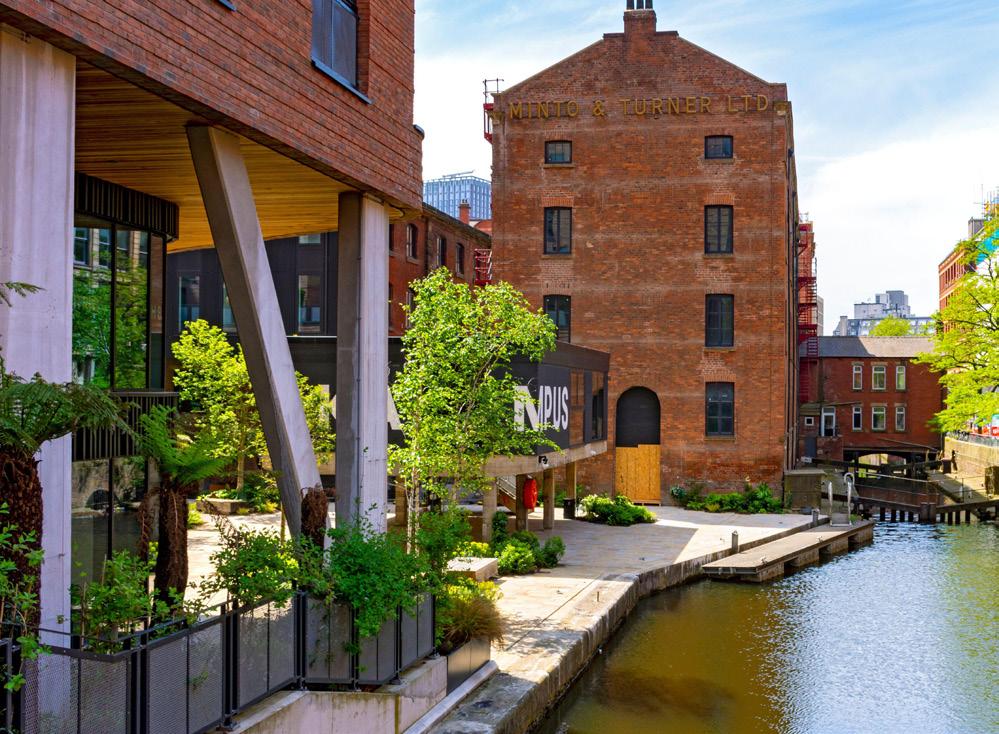
We were delighted to welcome a broad mix of clients and collaborators from across both the public and private sectors. Key guests included Barratt Homes, Gladman, Homes England and Historic England, along with many others who have played a vital role in shaping Iceni’s journey across the North West. Their presence was a testament to the strong partnerships that have been built and the collective commitment to delivering growth and positive change across the region.
The evening was full of energy, with guests enjoying Beeswing’s excellent tapas and supply of wine and beer. In fact, by 8:30pm the bar’s beer supply had completely run dry, something of a badge of honour, and a reflection of the enthusiasm and spirit in the room.
The night was not just about celebrating what we have achieved, but also about looking forward. With a strengthened Manchester base and a growing team, we are better placed than ever to support clients across the region. The event marked both a milestone and a springboard, and we look forward to building on this momentum in the months ahead.
by Ryan Walker, Associate, Strategic Advisory Service

On 10th June, against the backdrop of a warm summer evening in central London, Andrew Gale, Gemma Gallant and Ryan Walker joined a packed conference hall at Savoy Place for the 2025 Planning Awards. The atmosphere was buzzing as colleagues from across the industry came together to celebrate the projects and people shaping the profession most this year.
For Iceni, the evening held an unforgettable highlight: taking to the stage to be named Planning Consultancy of the Year. It was a proud moment for the whole team - and one that couldn’t have come at a better time. Just a day later, the entire company flew out to Tuscany to celebrate Iceni’s 20th anniversary, making the award the perfect start to a milestone weekend.
In presenting the award, the judges recognised Iceni for our strong commitment to community engagement, the delivery of social value across our portfolio of projects, and our ‘innovative approach to complex planning challenges’.
“In presenting the award, the judges recognised Iceni for our strong commitment to community engagement, the delivery of social value across our portfolio of projects, and our ‘innovative approach to complex planning challenges”
Now, as a recently accredited employee-owned business, we are excited to step into our next chapter – while staying true to the distinctive “Iceni way” that has defined us for two decades. Collaborative, creative and bold, it’s the approach that our clients value and the spirit that guides how we work with communities across the country.
by Lucy Furber, Associate, Planning (Manchester)

Next year will mark 10 years since Iceni established its Manchester Planning team. The team has evolved over this period, with us seeing the ebb and flow of the Manchester market - and we are now on a mission to reimagine the city’s planning services.
With the arrival of Danny Colins as Head of UK Regions bringing new leadership as well as Economic services to support our Planning offer, the office has a renewed sense of culture and ambition for growth.
Alongside myself and Justine Entezari, the Planning team has been bolstered by the arrival of Jordan Clark, who has joined us from Stantec as a Senior Planner, as well as the continued support of Thomas Humphreys as an Assistant Planner.
The vision is clear. Our goal is not to judge ourselves against other planning consultancies: it’s to accentuate what makes us different. To be the team that quietly and confidently wins multi-disciplinary work where
planning is the glue. Who else in Manchester can offer that? Iceni can – and that’s our USP.
We will work hand-in-hand with our London Planning colleagues and wider teams across the business as a strategic base for projects. The team will work collaboratively with others, to unlock opportunities and win work across the North West and beyond.
Iceni Manchester offers high-quality planning advice embedded in multi-disciplinary delivery, with expertise in planning, design, heritage, townscape, landscape, transport, economics and engagement.
Our clients trust us to bring the right strategy, with the right team, and at the right time, to solve complex development problems. Planning is our starting point – but it’s never the limit to our thinking. We aim to be known in the region as the high-integrity planning team that makes complex development possible, a trusted partner to local authorities, major landowners, and private developers alike.

“Our clients trust us to bring the right strategy, with the right team, and at the right time, to solve complex development problems. Planning is our starting point – but it’s never the limit to our thinking. ”
It’s a new era for our Manchester Planning team, and with confidence, purpose and high quality responsive delivery, we’re chasing excellence –not just market share.
With Danny’s regional reach and our grounded planning expertise, we have every reason to smile, stand tall, and own the room.
by Lucy Howes, Associate Director, Strategic
Planning

I originally joined Iceni as a graduate in 2013, when it was formed of 35 people working from a small serviced office around the corner from Tottenham Court Road station. From the word go, I learnt the ropes in an extremely collaborative and supportive environment, enhancing my planning knowledge whilst also having some fun along the wayincluding learning to ski and organising a company trip to the races!
Fast forward and Iceni is now in its 20th year and over 170 people strong - with a range of technical expertise in-house, spanning from London to Scotland.
Returning in April, there was a natural apprehension but that soon faded as I walked back through the doors. Iceni has grown in numbers but the fundamental ethos and culture has remained as it always was. We are a people focused, forward thinking, and collaborative consultancy - working together to provide valued advice to our clients. This is now embedded in our employee owned status and runs through everything we do.
It feels very good to be home and in a business that is staying different - but importantly the same.
by Danny Collins, Director, Economics

It’s an exciting time at Iceni as we celebrate our 20th anniversary and transition to an Employee Ownership Trust (EOT). Joining the business as Head of English Regions and Wales during this milestone, I see a real opportunity to continue doing things differently, delivering our unique, multidisciplinary, place-based offer to regions across the UK.
The UK Government has placed economic growth and wealth creation at the centre of national policy. Key to this are the delivery of housing, infrastructure, and the continued rollout of devolved powers to support regional growth.
The case for regional growth is clear; for years our regions and major cities have lagged behind in terms of productivity. If addressed, this productivity gap could add £80 billion annually to the national economy. A major cause of this productivity gap is related to opportunity, as articulated in the Levelling Up White Paper: “talent is everywhere, but opportunity is not.”
Our work across cities like Birmingham, Manchester, Liverpool, Leeds and Sheffield consistently reveals untapped potential. These places have the assets, ambition, skills and labour to be global leaders in culture, clean energy, life sciences, and advanced manufacturing. But they need the tools to turn potential into prosperity.
Now is the time for regional growth - and the scale of the opportunity is huge.
The Greater Manchester economy is now worth over £110bn, with growth over 58% over the last 10 years, making it the fastest growing city economy in the UK. In the West Midlands the value of the economy is £74bn, but growth has been slower.
Government intervention aims to unlock the potential of our regional cities, with devolution gathering momentum. Trailblazer deals for Greater Manchester
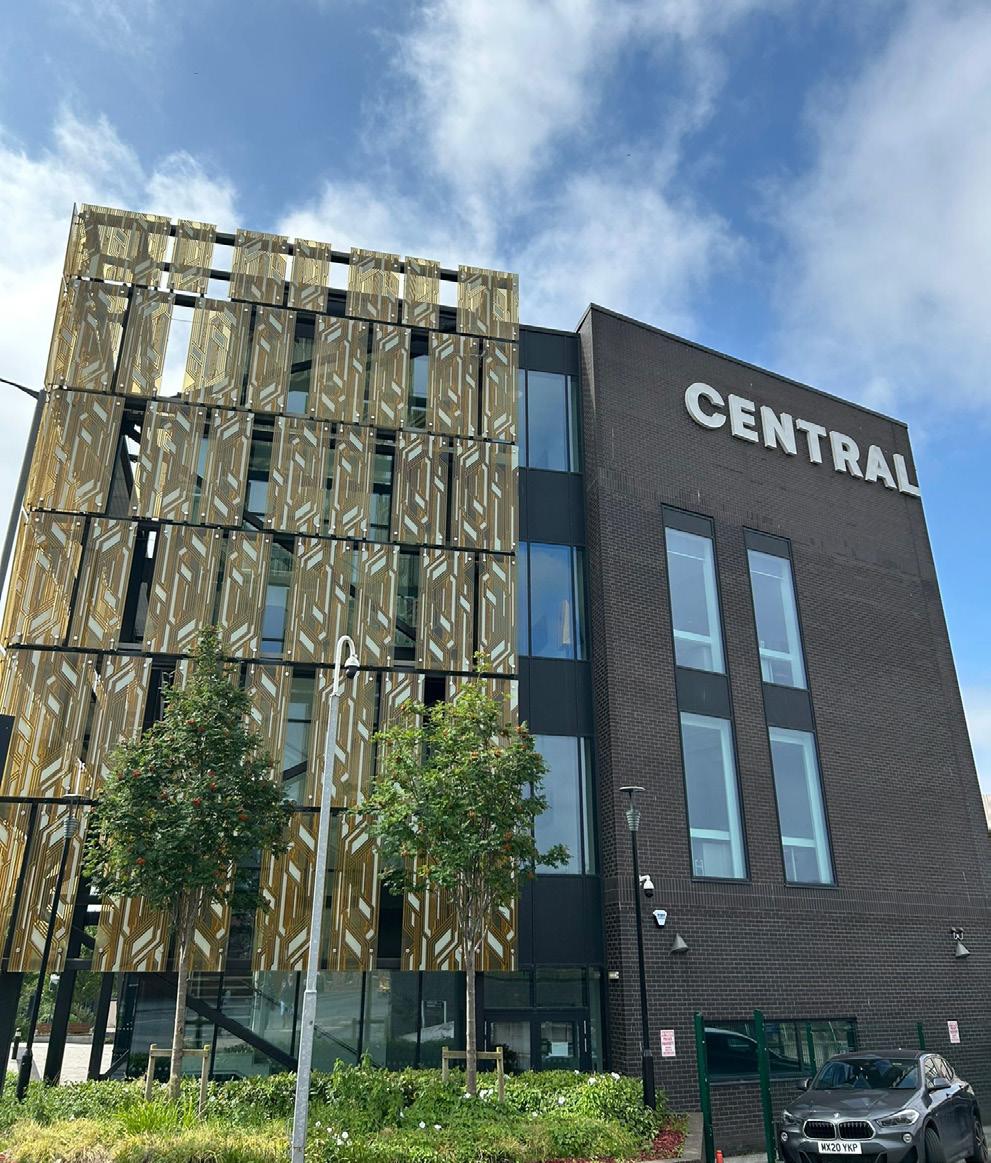
(£650m) and the West Midlands (£1.5bn) has given them unprecedented control over transport, skills, housing, and innovation funding. All areas across the country are now being offered the opportunity to establish combined authorities.
The Government is also supporting directly through regional targeted funding including:
£500m for Local Innovation Partnerships to drive local R&D and commercialisation
£50m for a new Mayoral Recyclable Growth Fund to support regeneration
£15.6bn for city-region transport infrastructure
£380m for regional investment in the creative industries
£67m already awarded to cultural regeneration in cities like York, Liverpool, and Leeds
The Government’s Modern Industrial Strategy also places regional clusters at the heart of national growth, with a focus on eight high-growth sectors (known
as IS-8) including clean energy, life sciences and the creative economy.
At Iceni, we’re ready to support this agenda. Our multidisciplinary model allows us to address complex, crosscutting challenges.
From day one, I’ve been impressed by the high-quality, multidisciplinary work already being carried out by our teams across the country. From Birmingham to Manchester, Milton Keynes to Leeds, our teams are already embedded in some of the UK’s most important regional projects. Our approach is simple: bring national expertise and local insight together to deliver tailored, place-specific solutions.
As an EOT, we’re empowered to think long-term, work collaboratively, and focus on social value. By working together as a national, multi-disciplinary collective, with boots on the ground in our regions, we can get under the skin of places, understand local issues, challenges and opportunities, and provide tailored high-quality responses.
We understand that no two places are the same. That’s why our focus is on helping regional clients, both public and private, to unlock opportunity and deliver sustainable, inclusive growth.
As we look ahead, we’re proud to be part of a movement that’s reshaping how and where growth is delivered. The opportunity for regional impact has never been greater, and we’re ready to lead from the ground up.
by Maisie Curry, Senior Economist

The viability challenge has been caused by a combination of inflation, low values, continued underinvestment, infrastructure needs and pressures on finance.
As business case and funding bid experts, we work closely with public and private sector partners to develop robust business cases and provide analysis to help secure public sector funding.
Over recent years, our team has been involved in securing over £450m of public funding for transformational schemes across the country. These include funding for a wide range of development types, from Grade A office, historic buildings, lab space, innovation space, simulation space, domestic violence refuges, gypsy and traveller accommodation, health services, residential development, all the way to major garden villages and strategic sites.
The public funding landscape, and the jargon that goes with it, can be complex and frustrating, but it doesn’t
“The public funding landscape, and the jargon that goes with it, can be complex and frustrating, but it doesn’t need to be this way.”
need to be this way. We help to cut through the noise, by being experts in the HM Treasury Business Case and Green Book Guidance.
A great example is our recent work for Liverpool City Council, who we helped to make the case for £15m of funding to be allocated to the long stalled, yet regional priority, Pall Mall scheme.
Pall Mall is a 100,000 sqft office scheme in the centre of the business district that will deliver Liverpool’s first Grade A new-build in over 10 years and help secure high value professional jobs in the city.

At the same time, we are supporting Sciontec - a JV between Bruntwood, the Council and Universitiesfor the 110,000 sqft Hemisphere One development in the Knowledge Quarter, which will unlock lab and office space, and act as an incubator for the highvalue life science industries.
These schemes can help transform the whole city economy – but are not deliverable by the private sector alone, they need help from the Government and the wider public sector.
Another good example is our work for Oval in Digbeth, Birmingham. Oval owns over 40 acres in Digbeth and has curated a unique blend of creative, digital, and studio space which is now gathering momentum and being recognised as one of the most important suburbs in the region.
However, the context for the place is changing. The combination of HS2’s arrival and the pressing need for
the West Midlands to close productivity and quality of life gaps, mean that Digbeth needs to do more.
We are helping to make the case for transformational change to meet changing needs in this complex urban environment.
The Green Book and government funding landscape is changing, but by staying on top of devolution and considering opportunities holistically, we can continue to support the public and private sector to unlock delivery and close the regional gap for good.



by Lyndsay MacLeod, Senior Planner, Scotland Planning

In June, Scotland Planning submitted Glasgow’s first detailed proposals for large-scale co-living for Copperstone Partners.
The application seeks planning permission for a highquality development comprising 420 co-living studios alongside ancillary uses, landscaping, amenity provision, access arrangements, and Use Class 3 (restaurant, café, food and drink) at 100 Morrison Street, Glasgow.
The proposal involves the demolition of a redundant office building to deliver a new energy-efficient development that will reactivate the site and contribute to the ongoing regeneration of the Tradeston area.
Designed by Claridge Architects, the scheme spans G+19 storeys and includes two roof terraces and a ground floor courtyard, offering generous shared indoor and outdoor amenity spaces to support communal living.
In May 2024, Glasgow City Council approved nonstatutory planning guidance for Large-Scale Co-Living (LCL). This guidance outlines a definition of LCLfor planning purposes, provides location context criteria and sets private living and communal shared space standards for development.
As the first detailed LCL application in Glasgow, we sought to explore and test the planning requirements for co-living, and guide stakeholders to better understand what distinguishes co-living from other alternative residential development. Specifically, co-living is a new, non-self-contained housing model in Glasgow, offering the potential to expand the
city’s housing stock through the creation of sociable, communal living environments. It can provide accessible accommodation for individuals who may otherwise struggle to meet their needs – for example, the duration of stay, quality of accommodation or level of convenience. By fostering social interaction, creativity, and innovation, co-living will deliver meaningful social and economic benefits to residents of Glasgow.
Working closely with our client and design team — who bring extensive experience in co-living — we developed a proposal that responds to Glasgow’s latest planning guidance and the city’s evolving housing needs.
We anticipate the application to be determined by the end of the year.
by Aidan Ball Albessard, Senior Consultant and Esme Coppock, Consultant, Built Heritage and Townscape

Earlier this year, Iceni’s Built Heritage and Townscape team in Scotland was asked by the City of Edinburgh Council and the Edinburgh World Heritage Trust to bid to produce a Statement of Heritage Significance for Princes Street and the Waverley Valley, an iconic area at the heart of the city.
We won the bid. Now nearing completion, the Statement of Heritage Significance supports the Council’s emerging strategy to revitalise the centre of Edinburgh.
For those arriving into Edinburgh by train, you will have experienced the unique upward arrival that welcomes passengers as they emerge into the ‘Great Arena’ of Waverley Valley.
Standing at the heart of the World Heritage Site, there are sweeping views of the Georgian New Town to the north, Playfair’s Greek Revival galleries above Princes Street Gardens to the west, Edinburgh’s medieval castle and Old Town to the south, and Arthur’s Seat and the Firth of Forth
to the east. It is easy to appreciate how the ‘Athens of the North’ continues to captivate visitors and locals alike.
Preserving this exceptional cultural heritage is the main goal of the Statement of Heritage Significance. This task goes beyond maintaining the façades of Edinburgh’s historic buildings. It requires a delicate balancing act: keeping the hub of the city’s busy public transport network running smoothly, carefully coordinating the numerous events and gatherings that bring the area to life, and supporting the economic vitality of Princes Street, a retail and hospitality destination that has attracted residents and visitors for generations.
On top of the day-to-day running of the city, proposals for the Waverley Station Masterplan are being developed alongside plans to renovate the Ross Bandstand, a public amphitheatre in West Princes Street Gardens. At the same time, careful consideration is being given to how Princes Street can maintain a lively mix of shops, leisure, and cultural attractions. All these factors are included in the Statement of Heritage Significance.
The Council is currently preparing a strategy document outlining its vision for revitalising Princes Street and the Waverley Valley. It recognises the impressive blend of culture, trade, and infrastructure within this area, and brings together multiple Council service areas for a coordinated approach to place.
Fundamental to this strategy’s success is ensuring that the attributes of Edinburgh’s World Heritage Site are preserved and, where possible, enhanced.
This means that the Statement of Heritage Significance we are preparing, which sits alongside the emerging strategy, needs to effectively communicate the international importance of Princes Street and the Waverley Valley and provide guidance on how appropriate changes can be made within the area. It will enable everyone, including developers, Network Rail, the Council’s Parks and Greenspace team, and their Transport department, to prepare well-informed proposals that protect Edinburgh’s Outstanding Universal Value for future generations.
Along with the Council and Edinburgh World Heritage Trust, we hope that this approach will allow residents and visitors to continue experiencing a vibrant, peoplefocused city centre with the right mix of land uses, which enhances community, as well as economic, and cultural life within an extraordinary historic setting.
Like so many other defining characteristics of the two cities, the arrival into Glasgow by train contrasts greatly but is equally dramatic. When arriving at Central Station from the east over the broad, steel and granite Caledonian Railway Bridge, one is immediately struck by the variation of buildings as well as their height.
This year, Iceni’s Built Heritage & Townscape team in Scotland has been directly involved in shaping the way new developments are integrated into this unique townscape.
In many ways, Glasgow is simply more than Edinburgh. The city is bigger, has a higher population, the urban grain is denser, the variation in building styles is greater, and the buildings are taller. A fundamental characteristic of the city
is its productive attitude to development which is related to its industrial success. Through our work, we have managed to highlight these characteristics as a uniquely positive way to understand the Glaswegian townscape and our opinions have been adopted by the decision makers of the city – Glasgow City Council (GCC).
When GCC opened their Tall Building Guidance Consultation period, we took the opportunity to provide them with comments based on our experience with development in the city. We highlighted through historical research that Glasgow is - and always has been - a tall city, and this is to be celebrated rather than apologised for. We also gave practical comments on how we think tall buildings should be assessed on a case-by-case basis, integrated throughout the city, and not exiled to the fringes of the centre.
Our comments were well received, with many taken on board in the final draft of the Tall Building Guidance issued by the City Council in May of this year. Our understanding of the city has helped shape how tall buildings will be assessed in the future. Ultimately, height is a factor, but quality must be the major player in any assessment. The Tall Building Guidance in its final form underlines the need for quality design, and recognises that whilst there is guidance, and areas that may be deemed more appropriate for buildings of height, they also need to be assessed on an individual basis, whilst drawing on guidance.
Following on from our successful consultation, together with our growing experience of supporting our clients and architects with buildings of height in the city centre, we are currently inputting into a Briefing Note for the council in relation to Heritage, Townscape, and Visual Impact Assessments (HTVIAs. This sets out to explain the importance of HTVIAs as a design tool, not as a document to be completed in isolation and submitted as a tick box exercise at the end of the process. Like our work in Edinburgh in relation to the Statement of Significance for Princes Street and the Waverley Valley, this document will help Glasgow City Council’s staff, as well as developers and designers. to positively engage with the process as part of the journey towards appropriate quality design that protects and enhances Glasgow’s existing townscape.

by Riley Bates, Software Engineer
This year has been about turning bold ideas into working systems that actively change how we approach planning. At Iceni, we have long recognised the need to embrace technology, but 2025 feels like a tipping point, a moment when automation and AI are no longer experimental, but integral to how we work as a business.
We have built our new platform, PLACES, to save time in the way we gather and use contextual information. Instead of trawling through multiple sources, colleagues can now instantly explore the facilities that shape a community, from schools and shops to hospitals and transport, around a site. This has reduced hours of background research to a matter of seconds, freeing up capacity for higher-value work.
Similarly, our EPC Mapping tool has transformed how we handle environmental data. By visualising the energy performance of commercial buildings across England, and allowing filtering by rating, we have created an internal system that makes a once slow and fragmented process quick and consistent. The tool ensures our teams can base their work on clear, reliable information without the time drain of manual collation.
We have also developed a Planning Application Monitoring System, designed to automatically collect and track planning applications. What was previously a resource-heavy task has now become a streamlined process, ensuring we keep on top of change without sacrificing team time. More importantly, it provides a live picture of activity that can be drawn upon whenever needed, without weeks of preparation.
Beyond the projects themselves, 2025 has also been a year of growth in skills. A trip to Perugia, Italy, working alongside Sharps’ software development team, provided the chance to deepen knowledge in Power Apps and automation frameworks. It was a reminder that innovation is not a solitary endeavour but something that thrives on collaboration, shared learning, and the cross-pollination of ideas.
Looking ahead, it is clear that automation and AI will continue to reshape how our industry operates. The pace of change is fast, the opportunities are vast, and the challenge for us all is to ensure we harness these tools in ways that add value, strengthen our processes, and ultimately make our work more effective.
For Iceni, the journey into automation is not about replacing the human dimension of planning, but amplifying it. By stripping out repetition and surfacing new intelligence, we create more space for imagination, dialogue, and bold decision-making. The planning system may never move at the speed of software, but our ambition is to ensure that the benefits of digital transformation are felt in every conversation about the projects we work on.
by Lewis Westhoff, Director, Planning

At the start of 2024, Iceni’s Retrofit and Repurposing Sector didn’t exist. But, by last summer, there were around half a dozen of us who knew we were working on plenty of retrofit projects with the desire to do more. Come the autumn, we’d collated our thoughts, written a business case, pitched the idea, and convinced the business that our newly formed sector should elevated into Super Sector status.
The business case for retrofit and repurposing is clear. Circa 400,000 million sqft of office space across the UK falls below an EPC rating of B, and the Government intends to require all commercial buildings to achieve an EPC rating of B by April 2030. In addition to the Government pushing for it, landlords need to do it, tenants increasingly want energy efficient accommodation and funders want to put their money into ESG projects.
That’s 400,000 million sqft of commercial floorspace where these buildings need to the retrofitted or repurposed into alternative uses.
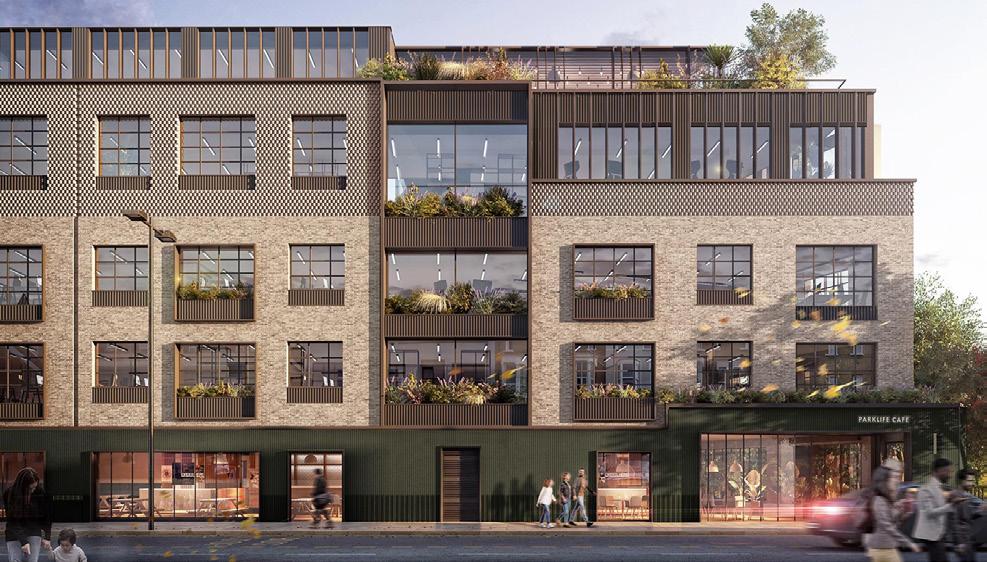

What do we actually mean by retrofit and repurposing? Retrofit is about breathing new life into existing commercial buildings: upgrading systems, improving energy performance, making tired assets competitive again. Repurposing goes further – reimagining those same buildings for alternative uses, whether that’s a hotel, residential scheme, or something altogether different. In short: making old stock work harder, smarter, and more sustainably.
The Sector has done a lot in the past year. We’ve turned over £1m in revenue, increased our quality and quantity of projects and clients), grown our network and collaborated with like-minded professionals, seen our geographical focus extend beyond London to the regions and Scotland, and we are now members of the British Council of Offices (BCO) – the industry’s leading authority on best practice in the office sector.
Our plan for the year ahead is to build on this momentum. We’ve got great new projects in the pipeline. We’re expecting to broaden our regional
reach, and we’ve got an ambition to develop into thought leaders, leading the conversation on best practice with our industry affiliations, including at key conferences including the Annual BCO Conference in Edinburgh next June.
You can see more of what we’ve been up to in our Retrofit and Repurposing Showcase.

by Lucy Morris, Associate Director, Strategic Planning
This year has been the year of the “grey belt”. Us planners love a buzzword and this one was something for us to really get our teeth into.
What was different about this particular buzzword is what it represented: one of the biggest shifts in Government policy in recent memory, on arguably planning’s most controversial topic: the Green Belt.
The Green Belt is, without doubt, an extremely successful planning policy. Created around London in the 1930s, the 1947 Town and Country Planning Act enabled other urban areas in England to create their own Green Belts in the context of a post-war housing boom. Today, 12.5% of England’s land area is classified as Green Belt - over 1.6 million hectares.
To the public, the concept of the Green Belt often conjures up images of the rural idyll: rolling hills, pleasant pastures and mountains green. But the Green Belt is a spatial designation, not an environmental one. The landscape quality of the land has no bearing on its classification as Green Belt - a nuance which understandably gets lost amidst all the technical jargon and political grandstanding.
Step in Labour and the coining of a new term: the grey belt. Invariably marketed to acknowledge that there are parts of the Green Belt which are unattractive, unsightly and already built upon, and set within the context of a deepening housing crisis and sluggish economy, the actual definition of grey belt which was confirmed in February has stretched far wider than we, as planners, had expected.
The result has been seismic (in the planning world at least). At Iceni, we have seen many of our long-term strategic promotions shift from plan-making to the preparation of planning applications. Sites which have felt like they have been playing the Hokey Cokey with planning policy changes over recent years, are now full steam ahead. We have also seen local authorities previously resistant to development, become more receptive to applications on grey belt land and approving schemes at a local level - something we had certainly not anticipated at the beginning of the year. It’s been an exciting time and an opportunity we have been eager to roll up our sleeves and crack on with.
However, simply being considered grey belt is not a free pass to development at any cost. One thing we have learnt over the past six months or so, is that sustainability is one of the most important considerations in the success of these planning applications. A poorly located and unsustainable grey belt site does not mean automatic permission - and rightly so.
For many, it feels like a “turning of the tide” moment. What remains to be seen is the impact this will have on the ability of Labour to meet its pledge to build 1.5 million homes this parliament and boost economic growth - and perhaps more importantly, in a world where housing delivery seems to be dealt with almost as an abstract concept, the real world consequences where home ownership remains out of reach for many.
by Kate Goldie, Associate, Planning
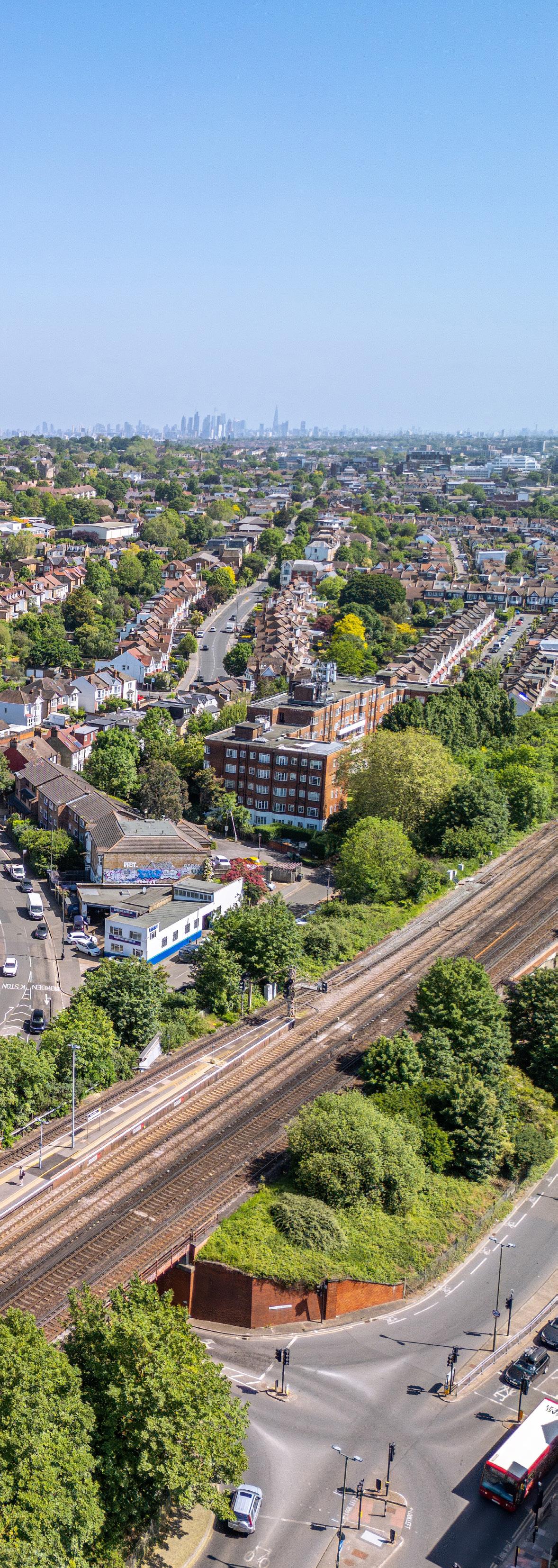
Take a left out of Tottenham Hale Station and you will soon come across a disused petrol station. Nestled within Zone 3 and next door to 500 flats, it doesn’t scream ‘green and pleasant land’, yet this site is designated Green Belt and has remained vacant whilst the area around it has transformed. As a result, this rather unassuming parcel of land has become a lightning rod in the neverending debate around Green Belt review. As successive governments refused to touch this particular political hot potato, it looked like this inconspicuous site in North London was destined to remain unloved, and crucially undeveloped. But not all heroes wear capes, and in this case the saviour of a derelict petrol station (and hopefully London’s housing delivery targets) has come in the form of a shiny new concept in the 2024 NPPF – the grey belt.
Metropolitan Green Belt makes up 22% of London’s land area, with 35,000 hectares located in the outer boroughs. A further 10% is designated as Metropolitan Open Land (MOL), which is afforded the same status and protection as the green belt under the current London Plan. Despite a delivery target of 52,000 homes a year, the most recent London Plan adopted in 2021 continued to toe the party line and resisted any release of green belt. But times are changing, a new Labour government is in power, and they are desperate to deliver on a manifesto pledge to build 1.5 million homes. So where is the Government targeting the greatest delivery of housing to be from? Well, it’s our great capital city of course.
Emboldened by this grey belt approach and with a new annual housing target of 88,000 homes, Sadiq Khan has done the seemingly politically unthinkable and elected to undertake a full-scale review of London’s Green Belt as part of the new London Plan. In recognition that not all of London’s housing growth can come from brownfield sites (indeed starts on brownfield land across London over the last 12 months have slumped to just 6,000), part of this strategic exercise will be to identify appropriate grey belt sites and release them from their Green Belt shackles - unlocking potentially thousands of hectares

of sustainable and well-connected land in the outer boroughs for development. It’s fair to say this review is something of a housing delivery game changer and presents an opportunity for our clients to look again at sites which may previously have been discounted.
Whilst the new London Plan seeks to review Green Belt restrictions, in relation to MOL, the Plan proposes to distinguish this designation under its policy approach. To qualify as MOL, land is subject to additional criteria and often provides valuable open space provision for Londoners. Whilst the direction from the GLA seems to be that MOL will generally be protected, there is an acknowledgement that some areas of MOL, such as golf courses, which are not accessible to the wider public and have limited biodiversity value, could have the potential to be released for development.
Although the GLA is keen to sever the connection between Green Belt and MOL, under the current London Plan, MOL is linked to national Green Belt policy, meaning that MOL in London could now potentially be considered against the NPPF tests for identification as grey belt. In this interim period before a new London Plan is adopted which strengthens the policy position to protect MOL, there is an opportunity to submit applications for MOL sites which could be deemed grey belt.
Whilst City Hall may have grabbed the Green Belt bull by the horns, the outer London boroughs with the greatest share of it (Bromley, Havering and Hillingdon) are not under Labour control and may not be as enthusiastic about a Green Belt review as the Mayor.
A consequence of this may be that future grey belt/ Green Belt release schemes which are GLA referable end up being called in for determination as they are resisted at a borough level.
Another key battleground between the Mayor and these outer boroughs is the type of new residential development which is considered appropriate on any grey belt or Green Belt released sites. To drive the numbers needed to hit the 88,000 homes target, the GLA will push for primarily high-density, flatted schemes close to stations. But these types of schemes do not necessarily fit with the general housing typology of the outer boroughs, where the commercial demand is also more suited to larger family houses with parking. There is a question mark over whether the quantum and type of flatted development the GLA will want these grey belt sites to achieve is fully deliverable, and if in their push for numbers they end up actually slowing down delivery. A key borough to observe for an indication as to how this matter will play out is Enfield, with their Local Plan currently at examination. The GLA have objected to two proposed Green Belt release site allocations on the basis that the lower density, large scale family housing proposed does not make the best use of Green Belt land.
It’s important to note that grey belt sites in London do not have to wait for adoption of a new London Plan in 2027 to come forward. In fact, given how fickle the political and planning landscape is, it would be prudent to take advantage now of the currently favourable NPPF position in relation to grey belt. If a site passes the NPPF grey belt purposes test (and for residential development complies with all the ‘Golden Rules’) then the adopted London Plan cannot restrict an application being made as its policy in relation to Green Belt defers to the NPPF.
With a recent demonstrable uptake in appeal success for identified grey belt sites, there has never been a more opportune time to submit a planning application for a London site which could be deemed grey belt and which is within a borough that can’t currently demonstrate a 5-year housing land supply (I’m looking at you Bromley and Havering). At Iceni we are experts in defining if a site is grey belt and we are always happy to assist clients with an initial site appraisal.
by Tim Fleming, Associate, Planning

It has been a busy year for Iceni’s new Retrofit and Repurposing Super Sector.
We are seeing an influx of these types of schemes with a flight to quality in amenity rich areas of Central London, with the supply for high end, Grade A office space unable to match growing tenant demand. This places significant emphasis on landowners and developers to invest in the right way and in the right location.
Local Authorities and Central Government are also driving this change with the majority of Central London authorities having now declared a ‘Climate Emergency’ which is manifesting in planning policies being updated to introduce a Retrofit First principle.
Our clients are up to this challenge and have been keen to raise the bar for retrofit-led regeneration projects across London. Some of recent project wins are set out below and you can find more in our sector brochure.

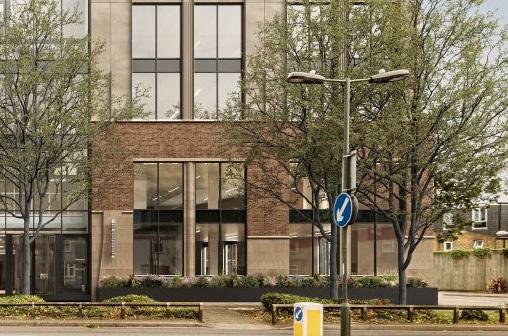
Together with our client Barings we helped secure permission to deliver a high quality retrofit and extension of this existing building which would see the creation of 1,000sqm of additional office floorspace, enhancing its sustainability credentials, improving its street presence and creating a more modern, flexible and attractive workspace. The rebranded scheme – “The Greenhouse” – reflects a broader ambition: to create a future-ready building that responds to its setting adjacent to Kew Gardens and puts wellbeing at its core.
Together with our client Art-Invest we helped secure permission for refurbishments and roof level extension of the Grade II listed Sackville House and associated townhouse.
Advising on the comprehensive refurbishment and roof level and rear extensions to deliver over 1,000sqm of additional office floorspace.
Advising on the comprehensive refurbishment and roof level extension to an existing office building in the heart of Fitzrovia.
Retrofit of the existing building to re-provide retail space, with office and residential above.

by Stuart Mills, Associate Director, Strategic Planning
2025 feels like the year when AI really took off, and alongside this we have seen an increasing awareness of the role and importance of data centres. Of course, data centres have been around for a long time, but their increasing scale, changing function and the sheer number now coming forward has been particularly notable.
We have seen a more positive attitude and support from the Government, reflected in national policy and Secretary of State decisions, as well as some local authorities positively welcoming the opportunity to be part of the new tech revolution (and the associated business rates).
Alongside this, there has been increasing awareness of some of the challenges associated with date centre developments, including environmental impacts and the ongoing issue of securing connectivity to the electricity grid.
We are still in the early stages of establishing how to quantify the ‘need’ for data centre development at a local, regional and national scale, and this is likely to be a key issue to work through in the next generation of local and regional plans going forward.
However it is clear that significant demand still remains, with landowners and developers increasingly considering the potential for data centre uses alongside other more traditional development options.
We have witnessed this growth of the data centre sector first-hand at Iceni, with an increasing number
of active instructions over the last year. Recent work has included supporting Google in their delivery of the proposed North Weald and Thurrock Data Centre Campuses, and Ark Data Centres and Colt Data Centres in West London. We have also been undertaking site searches and feasibility studies for a number of clients, promoting sites through the Local Plan process and engaging with partners across a range of disciplines including engineers who specialise in data centre developments.
With a number of active instructions for new data centres in the pipeline across the UK, the next 12 months are set to be even busier than the last in this exciting and fast developing sector!
by Tim Fleming, Associate, Planning

The City of London’s office market is bustling. Recent analysis from CBRE shows that there has already been 2.2 million sqft take-up of office space within the first half of this year, representing a 7% increase year-on-year.
Vacancy rates are continuing to decline, and have been reported as low as 8.1% overall. Demand for Grade A best in class office space has never been greater, with record rents being achieved at the recently completed 8 Bishopsgate pushing £150 per sqft. . Vacancies for Grade A space are now being reported as low as 1.4% and it appears that demand is outstripping supply with almost half of the new Grade A stock coming into the market pre-let.
The City are ambitious to match this growing demand with the vision and target to deliver 1.2 million sqm of new office floorspace by 2040 set by their new Local Plan, expected to be adopted next spring. The policy setting and political leadership to deliver this is strong, which is in turn driving up market confidence to
invest. There is a growing push to ensure that London continues to retain its status as a global financial hub which can attract top talent from around the world.
At Iceni we are advising an increasing number of owner occupiers and landowners on the retrofit and repurposing of buildings to deliver best in class Grade A office accommodation, such as 10 Warwick Lane which will be the new headquarters for Fox’s Burton’s Companies. They were attracted to the Square Mile due to the world-class amenities which surround the building and the associated benefits these will bring in attracting the best employees to this iconic British brand. We have also been advising several asset managers on strategies to retrofit existing buildings to deliver Grade A office stock that meets best in class sustainability and ESG metrics to meet growing tenant demand. Recent examples include Cannon Bridge House and 90 Queen Street which are both high quality buildings in prime City locations.
Whilst there is clearly demand for Grade A office space, several poor-quality secondary office buildings

are struggling to find tenants, and in some cases it is becoming uneconomic for landowners to upgrade them to best in class standard. The City has recognised this challenge, and is now actively encouraging uses that attract visitors, workers, and residents throughout the week, from hotels and cultural venues to restaurants, retail, and leisure. Strategically located conversions of lower-grade office stock into alternative uses can deliver multiple benefits including delivering whole life carbon benefits through retrofitting existing building stock, supporting tourism, providing much needed accommodation for business travellers, boosting the evening economy, and encouraging greater footfall across the area.
We are working with several landowners on change of use strategies for poorly performing office buildings in off-pitch locations that cannot compete with the higher quality office stock in prime locations. This has included advising on the change of use of St Mary Abchurch House, 8-9 Lovat Lane, and 25-26 Lime Street from office buildings to hotels or short-term accommodation.
The City’s pragmatic and balanced approach has been welcomed by the market. This problem is not unique to the City and also exists in other Central London authorities who in our experience are more protective of existing office stock and less open to a change of use. The City are demonstrating that it is possible to deliver a consistent pipeline of Grade A office stock and to also take a flexible approach when it comes to change of use of these buildings. At Iceni, we will be keeping a keen eye on the ongoing policy developments across Central London and would advocate for other authorities to follow suit.
by Rebecca Mason, Associate Director, Built Heritage and Townscape

It’s a busy time for the built environment. From housing to commercial and cultural infrastructure, everyone is building, and pressure is mounting to deliver at pace. The development landscape has shifted decisively from aspiration to execution, with clients, funders, and end-users alike demanding results on site, not just ideas on paper.
This is especially visible in heritage, where a growing number of schemes now involve the adaptive reuse of historic buildings. Driven by environmental priorities, planning policy, and the cultural prestige of heritage-led design, developers are increasingly looking to unlock the potential of our existing building stock. Change of use schemes are on the rise: turning old offices into hotels, government buildings into co-working hubs, and underused civic assets into dynamic public spaces.
These projects have clear benefits, from embodied carbon savings to local character retention, but they also carry a distinct set of delivery challenges. As
Heritage Consultants, we often find ourselves at the crux of these tensions, helping clients, architects, and contractors navigate a path that is both conservationled and commercially viable.
At concept stage, the narrative is often optimistic: what a building could become, how it could serve a new purpose, how its historic identity could shape a unique outcome. But delivery, when boots are on the ground and walls start coming down, is where the real complexity sets in. Heritage constraints become tangible, practical issues. Historic fabric, assumed to be straightforward, turns out to be fragile, inconsistent, or undocumented. And decisions made early on, often under time pressure, must now be tested against technical feasibility and cost.
This is why delivery-stage heritage advice matters so much.
A project we’ve recently supported in Whitehall is a compelling example. Set within one of London’s
“As our clients face increasingly ambitious project timelines, tighter margins, and heightened scrutiny, they need heritage consultants who understand the delivery context: how construction programmes work, what contractors need on site, and where flexibility is possible within the boundaries of significance and consents.”
most politically and architecturally significant streetscapes, the scheme involved the transformation of an 18th century building into a high-quality, secure commercial workspace. The heritage significance of the site was multifaceted, from its historic fabric and context to its planning history and public symbolism. And while the principle of change had been carefully negotiated at consent stage, the realities of delivering a workable scheme on site required considered, responsive heritage input at every turn.
As the design evolved to meet end-user requirements, our role was to help ensure that proposed changes remained consistent with the conservation principles established at the outset, whilst helping the team respond flexibly to unforeseen challenges. We worked closely with the contractors to develop mitigation strategies for works to significant elements, advised on suitable recording and reinstatement measures, and facilitated ongoing dialogue with statutory stakeholders to maintain confidence in the project’s heritage integrity. Our presence on the delivery side helped the team navigate inevitable tensions without delay, avoid costly missteps, and ultimately deliver a scheme that was both operationally successful and, most importantly, compliant.
This kind of delivery-focused heritage consultancy is something we are increasingly championing across our work. While early-stage advice remains essential, particularly for obtaining consent and shaping design strategy, it is only part of the story. The ability to interpret, adapt, and problem-solve in real time during construction is what allows complex heritage projects to succeed in practice. It is not about policing outcomes or blocking progress, it is about being an enabler of informed, confident decision-making.
As our clients face increasingly ambitious project timelines, tighter margins, and heightened scrutiny, they need heritage consultants who understand the delivery context: how construction programmes work, what contractors need on site, and where flexibility is possible within the boundaries of significance and consents. This is especially true for change of use schemes, where the overlay of modern function onto historic fabric creates layered technical and design challenges.
For us, delivering schemes with a heritage component is about much more than compliance. It’s about helping historic buildings thrive in a contemporary world, not preserved as relics, but adapted as assets. It’s about ensuring that what makes a building special is retained and enhanced, even as its use changes. And it’s about providing clear, practical advice that supports delivery teams under pressure to meet demanding targets.
There is huge opportunity in this space. And as our practice continues to grow, we are actively seeking to support more clients during the delivery phase of heritage projects, particularly those involving ambitious adaptive reuse. Our team brings deep expertise in complex urban sites, a proactive and collaborative mindset, and a commitment to high-quality outcomes, both for heritage and for the people who use these spaces every day.
by Lucy Howes, Associate Director, Strategic Planning

Following historic site promotion through the Local Plan process (which has been ongoing since I started as a graduate in 2013), in October 2024 Iceni submitted an Outline planning application (with all matters reserved except access) on behalf of Estates & Agency Strategic Land for a new sustainable, mixeduse community in West Horndon. This is known as Horndon St Marys.
South Essex is identified as a national priority growth area, with one of the highest anticipated increases in inward investment and GDV in the country. Horndon St Marys is in a truly unique position in Thurrock, immediately adjacent to West Horndon station which is on the London to Tilbury and Southend railway line. This benefits from a frequent service connecting West Horndon to the City of London.
Horndon St Marys is also strategically located on the road network, close to the A127, which is the central corridor through South Essex, forming the key strategic link
between London and Southend. It has been identified as an Economic Growth Corridor, with the Borough also home to several existing and emerging sources of employment – including DP World, Thames Enterprise Park, and Port Tilbury.
Owing to nature and scale, Horndon St Marys would be able to support investment and early delivery in community, transport, and green infrastructure alongside housing, building upon existing sustainable transport infrastructure, whilst optimising opportunities for enhancing existing connections in a truly sustainable way.
Working closely with officers at Thurrock Council, a landscape and design-led approach has been adopted from the outset, which seeks to integrate the proposals into the existing surrounds. This includes restoration of fenland, as well as enhancements to, and incorporation of new ecologically rich and diverse green and blue infrastructure. A careful consideration of views has also been necessary in evolving the masterplan, with Iceni’s Planning,

Landscape, Heritage, Engagement, Sustainability, Design, Transport, Archaeology and EIA teams working closely alongside other industry professionals to ensure key technical matters were considered as early as possible in the process. The application has also been designed to ensure resilience to market change and future flexibility, noting that Horndon St Marys will come forward on a phased basis over time.
Early and collaborative engagement has also been pursued with the community and with key stakeholders alongside two sessions with Design: Southeast Design Review Panel. Discussions with Brentwood Council were also pursued, given that Horndon St Mary’s bounds this administrative area. This has also helped to ensure that the proposals take account of broader strategic considerations in the interests of proper placemaking and ensuring that Horndon St Marys becomes an inspiring place to live, work and visit.
The application is currently subject to determination with Thurrock Borough Council.







A new multi model transport hub at West Horndon Railway Station
Land for a new primary school
A care home and integrated retirement community
Local centre with a range of commercial uses
2,100 new dwellings, including 50% affordable and custom/self-build
Open space, public realm and ecological enhancements (including biodiversity net gain)
New bus and active travel route and upgrades to existing highways infrastructure
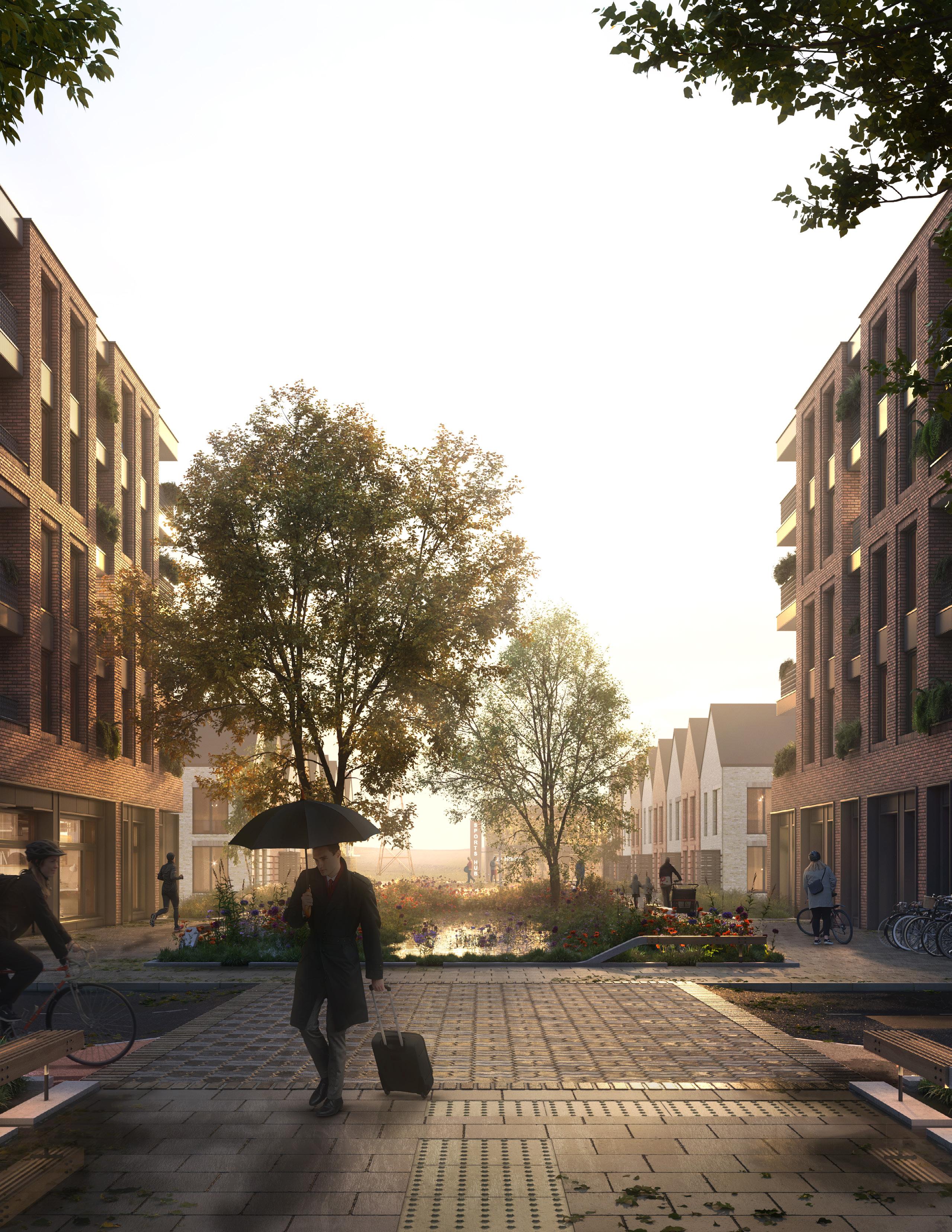
by Grace Wileman, Associate, Iceni Futures
It is clear that with the global climate constantly changing, we are entering a period of accelerating volatility that will affect communities and the environment alike. It is imperative that the places within which we live and work are resilient and adaptable to these changes, whilst also providing opportunities for all to lead happy and healthy lifestyles.
Horndon St Marys places people and nature at its heart, which will allow it to become a truly diverse, inclusive, and sustainable place that is able to support the current generation, and those to come.
Through the implementation of our Environmental, Social and Governance (ESG) Strategy, Horndon St Marys proactively responds to the pressures of a changing climate, whilst also delivering wide-reaching benefits to both future residents, and those living within the existing communities of West Horndon and the surrounding area. The creation of a community-led Stewardship Body will ensure future residents of Horndon St Marys are empowered to manage and maintain the public spaces and community assets to come forward. To support this, a Decision Making Body will be established, the predominantly comprising residents of Horndon St Marys, alongside elected representatives of the local authorities and parish councils. This, alongside the creation of a Strategic Steering Group, will ensure decisions are made by those living within Horndon St Marys and the surrounding area, facilitating the integration of new and existing communities.
As demonstrated with our Sustainable Development Scorecard Assessment, the golden thread of
sustainability set out within the National Planning Policy Framework is firmly embedded within Horndon St Marys. Substantial environmental, social and economic benefits will be delivered as part of the proposals, including:
The intention to achieve net-zero carbon dioxide emissions in operation by 2035, subject to the ongoing decarbonisation of the national electricity grid.
Achievement of a significant biodiversity net gain through the development of a landscape-led scheme that enhances the Mardyke corridor.
Creation of a place designed for all, with a range of housing provision and enabling access to facilities, services, amenities and employment opportunities all within walking and wheeling distance.
Provision of a healthy environment that maximises community health and wellbeing.
Introduction of new local centre, as well as dedicated employment floorspace, to deliver long-term employment opportunities, and to support the local economy.
Horndon St Marys will be a thriving, future-proofed and resilient community, that delivers opportunities for future residents and visitors from all walks of life. The robust governance and long-term stewardship of Horndon St Marys will ensure all residents have the opportunity to shape the place in which they live, work and play.
by Paul McColgan, Director, Economics

Every autumn, thousands of students leave home for university — often choosing their destination as much for accommodation as for courses. Yet the world of student housing is becoming increasingly strained.
The number of people choosing to study in the UK has increased by around 600,000 since 2012/13, and the student age population in England is expected to grow by a similar number by 2032. Demand for student housing is therefore only likely to increase.
But demand for student accommodation is not just a domestic issue; universities are increasingly reliant on international students just to make ends meet. Around 23% of all students in the UK are from overseas, up from 12% in 2012/13.
University finances may also necessitate further increases in international students, and while the rhetoric around immigration may be hardening, the Labour Government unambiguously welcomes international students.
However, other government policy in the form of the Renters Reform Bill has prompted many landlords to leave the student housing market, citing complications around ending tenancies and limiting the role of guarantors.
This has resulted in the supply of rental accommodation falling at a time when it is needed the most, which is where Purpose Built Student Accommodation (PBSA) comes in.
In some cities, new PBSA schemes have already transformed skylines, raising concerns of potential oversupply. Elsewhere, however, genuine need remains — though local politics often makes delivery contentious.
PBSA does, however, have a crucial role in the housing market ecosystem, and its benefits need to be spelt out to objectors.
Iceni has run this argument in a number of locations in the last year and has successfully supported over 1,000

additional bedspaces being granted. In doing so, we have made numerical, social, and economic arguments.
PBSA’s primary role is to provide much-needed housing to meet student demand. As mentioned, with university expansion and landlord retraction, the existing lack of supply is pushing up rental costs as demand soars.
The days of grotty bedsits being acceptable for student housing are long gone, with students today much more discerning about where they live and study. To capitalise on this, modern PBSA developments typically provide a greater range of facilities, are better managed and are of higher quality than alternative rental accommodation.
PBSA developments often provide pastoral care that private landlords cannot, helping to improve mental health and reduce dropout rates. In most cases, where universities support PBSA, they seek cluster flats to promote a more social experience. However, unlike studios, cluster flats have limited alternative uses if demand falls.
In some areas, PBSA can also help deliver affordable student housing to help support students from less privileged backgrounds go to university, albeit these are choppy policy waters that need to be carefully navigated.
If priced competitively, PBSA can also help draw students out from traditional housing stock, releasing it for urgently needed family housing. Similar arguments are also made for other forms of specialist housing, such as extra-care.
Finally, PBSA is often located in city centres and can therefore play an important role in repopulating and revitalising failing areas by increasing footfall and expenditure. In doing so, PBSA not only supports students but also strengthens local economies, sustains jobs, and breathes new life into city centres.
For Iceni, making the case for PBSA is about more than numbers — it’s about supporting universities, strengthening communities, and helping cities thrive.
by Rabeka Begum, Assistant Planner
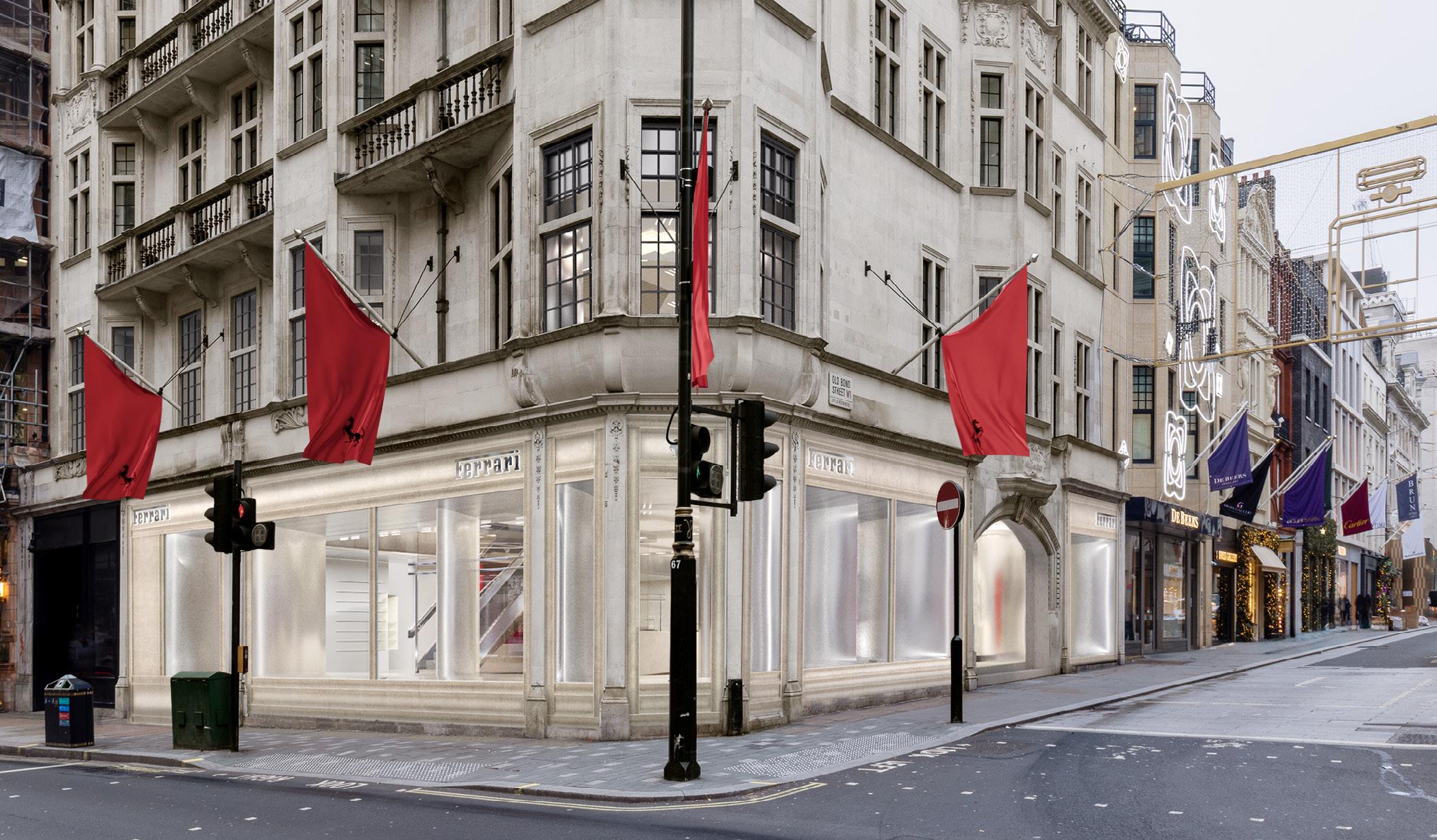
Ferrari S.p.A are part of the wider international brand founded in 1939 by Enzo Ferrari (18981988), renowned for its automative, racing and engineering heritage, and synonymous with opulence, craftmanship, quality, exclusivity and refined luxury.
Given the brand’s long history and pedigree, Ferrari’s chosen location for their new London international high fashion brand and boutique business sits at the heart of Westminster, occupying a prominent corner at 45–50 Old Bond Street, London W1S 4QT, where Old Bond Street meets Piccadilly. As the first of its kind, the unique scheme’s overall objective was to invest, enhance and renew the store in a manner commensurate with Ferrari’s heritage, status and quality. Old Bond Street is a designated international shopping street and one of the world’s most important retail destinations within the City of Westminster.
The Iceni London Planning Team were involved throughout the process from pre-application discussions with the council and preparation of the submission, through to post-submission engagement
and determination, playing a key role in the scheme’s success. We ensured that the development proposals were carefully considered and revised based on the Council’s feedback regarding both internal and external alterations. This collaborative approach was vital for aligning Ferrari’s vision with the strict heritage and planning guidelines of Westminster.
By securing full planning permission, Listed Building Consent and Advertisement consent, Ferrari are able to create a magnificent retail space that not only showcases its luxury lifestyle brand but also significantly enhances a Grade II listed building and contributes positively to the character of the Mayfair Conservation Area. This development is a testament to Ferrari’s strategic vision and Iceni’s commitment to design excellence, and ability to navigate complex planning environments to establish a preeminent London presence that will enable it to excel and compete in an increasingly competitive global marketplace.
by James Waterhouse, Director, Strategic Planning
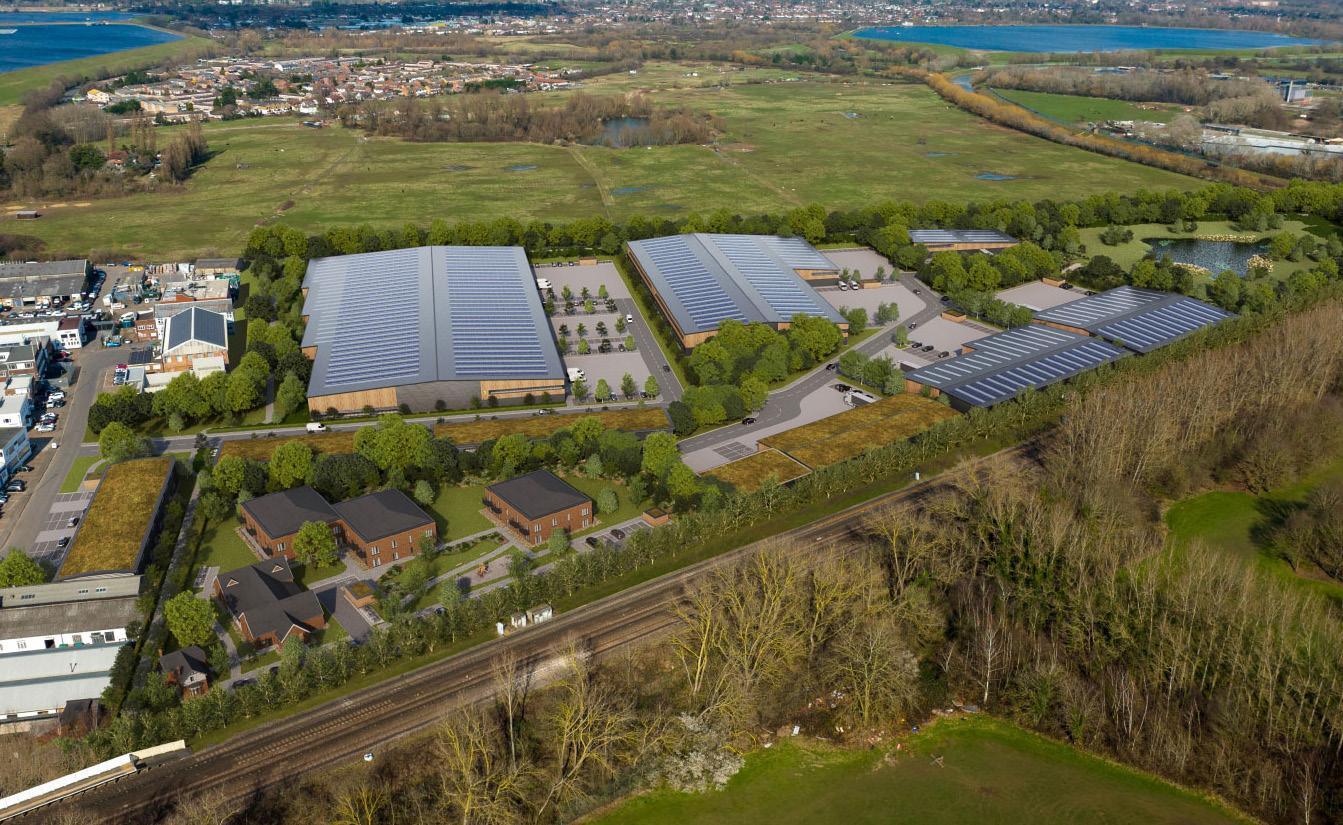
In April, we had the pleasure of securing an appeal win on an 11Ha former Sewerage Treatment Works site in Surrey’s Green Belt for a 500,000sqft commercial-led mixeduse redevelopment with affordable housing. Significantly, this was one of the first major appeal decisions to establish a scheme as qualifying grey belt development.
The redevelopment had been carefully conceived in its design and uses to ensure that it would address the concerns of the local community in Hersham , the local planning authority in Elmbridge and Surrey County Council, the waste authority, as it was a safeguarded and allocated waste site. All whilst simultaneously creating a scheme of commercial value that could enable significant infrastructure investments to create a successful modern business estate. In truth, the decision invoked mixed feelings of relief and vindication for both Iceni and our client, Northumberland Estates Ltd, as the scheme should never have had to be pursued to appeal. In this regard, the benefits of the redevelopment so clearly justified planning permission being granted and great
efforts had been made both to establish support for the scheme locally and to ensure that all statutory and technical consultees were satisfied with the scheme. Given the application had the benefit of a thorough and excellently prepared officer’s report recommending approval, it was a huge frustration that the scheme needed to be pursued to appeal in the first place.
The scheme was a true Iceni team effort, with the Public Inquiry hearing evidence from our planning, landscaping and economics experts, whilst the application had been underpinned by an EIA produced by our impact management team, with additional support provided through our heritage and socio-economics teams.
We are now retained to take forward reserved matters applications to enable Northumberland Estates to do what they do best; which is to adopt long-term approach to creating sustainable new places for the future and delivering lasting social and economic benefits. This is exactly the kind of client we are honoured to support.
by Ashleigh Bullough, Associate Director, Planning

Following our attendance at the Future of Co-Living Investment and Innovation Conference in April, Iceni’s Alternative Residential Sector Group has been reflecting on the role of co-living within the residential sector.
As the UK continues to grapple with housing affordability, shifting lifestyle preferences, and demographic change, co-living is emerging not just as a niche alternative, but as a credible and dynamic residential model. We are seeing increased interest and activity in the co-living space, driven by investor appetite, occupier demand, and the growing realisation that this model addresses genuine gaps in the UK housing market.
The UK is leading the way in Europe when it comes to co-living. It is now the continent’s most mature market for this product, with over a third of all planned European co-living schemes based here. Our ongoing work reflects this trend: clients are pursuing high-quality, well-located developments, while some local authorities
are starting to recognise co-living as part of the broader housing solution, particularly when schemes demonstrate clear demand, thoughtful design, and experienced delivery teams.
Demand drivers are compelling. Currently, 13% of the UK population lives alone, and a further 4.6 million adults live at home with their parents. As urbanisation continues, urban household numbers are projected to rise by 8% over the next decade, and so flexible, well-designed housing options are needed more than ever. Co-living offers an increasingly attractive proposition for younger professionals, key workers, creatives, and digital nomads seeking community, flexibility, and quality.
Investor confidence in the sector remains robust. There is particular interest in schemes of 200–400 bed spaces, which tend to strike the right balance between operational efficiency and ease of funding. Larger schemes benefit from economies of scale, while smaller formats can offer a more boutique, localised appeal.

Either way, the viability of these projects is closely linked to location, design, and amenity.
It’s clear that expectations for the co-living product are evolving. Investors are increasingly involved in shaping schemes, prioritising:
Location: Proximity to transport hubs and higher education institutions remains a key determinant of success. Co-living can offer a natural next step for graduates moving on from purpose-built student accommodation.
Room sizes: While the London Plan sets a minimum size of 18sqm, there is growing demand for larger rooms (23–25sqm), reflecting residents’ desire for more generous private spaces. Double occupancy rooms are also gaining popularity.
Amenity spaces: The next generation of co-living demands multifunctional, future-proofed communal spaces. Traditional lounges and dining areas remain
important, but are now being complemented by podcast studios, wellness areas, and co-working zones. Flexibility is key.
Perhaps the most persistent myth surrounding co-living is the notion that it encourages transient living. In reality, the model promotes stability and community. Flexible tenancy lengths, ranging from three to twelve months, cater to modern living patterns. Data shared with us from our client Halcyon Development Partners shows average stay lengths align with those in Build to Rent schemes, with many residents staying over a year.
While challenges remain, particularly around planning and compliance with the Building Safety Act, co-living is proving itself to be a forward-thinking response to changing urban lifestyles. With the right partners, the right sites, and the right standards, co-living is well placed to continue its upward trajectory in the UK housing market.

by Emilia Harrison, Planner
In 2024, Feldburg partnered with Street Art for Mankind (SAM), a UN-backed non-profit organisation, to deliver a striking new mural on the elevation of Regal House, Twickenham. SAM unites internationally renowned artists to create impactful public artwork that addresses urgent global challenges while enriching the communities where they are located.
The Twickenham mural forms part of SAM’s global initiative to produce 50 large-scale works raising awareness of the need to halt and reverse ecosystem degradation. Previous pieces in the series have been unveiled in Brussels, Houston, New York, Detroit and Seattle. Twickenham now hosts the sixth installation, designed by Vesod, an Italian artist celebrated for his distinctive style combining renaissance influences, futurism and geometric abstraction.
The mural, titled N6tur3, has transformed the previously blank façade of Regal House into a cultural landmark. Inspired by the figure of Mother Nature, the composition presents a poetic vision of a future where urban life and the natural world coexist in balance. A central anthropomorphic willow tree symbolises the bond between people and nature, surrounded by local riverside fauna including kingfishers, herons, water voles and badgers. The imagery suggests both harmony and resilience, with the metamorphosis of London into a river landscape suggesting the possibility of transformation and balance between humanity and nature.
Following a successful determination period and the granting of planning permission, Vesod began painting
on site. Working section by section whilst suspended from the building, he completed the mural in just over a week, ensuring its unveiling coincided with the England v Italy Six Nations fixture at Twickenham Stadium.
Community engagement was integral to the project. Local schools were invited to meet Vesod, hear about the creative process and subsequently develop their own artwork inspired by the mural. This engagement provided a unique educational experience, encouraging young people to reflect on environmental themes through creative expression.
The mural was officially unveiled on 9th March at a well-attended event featuring the Deputy Mayor, Ward Councillors, the Co-Founders of Street Art for Mankind, Vesod, and the Deputy Leader and Chair of Environment at Richmond Council, alongside residents.
The mural has quickly become a prominent landmark, reinforcing Twickenham’s identity and sense of place. It demonstrates the potential of creative partnerships to deliver projects that are globally relevant and locally meaningful. By celebrating themes of restoration and resilience, the mural contributes to both cultural enrichment and community pride in Twickenham.
by Finn O’Donoghue, Planner

In an industry where large-scale redevelopment and iconic masterplans often dominate headlines, it is important to recognise the equal power of long-term collaboration, shared values, and cumulative change. The working relationship between Akoya and Iceni Planning, demonstrated over years of shared work on Lonsdale Road in Queen’s Park, is a great example of the power of sustained partnership and a shared commitment to meaningful, sustainable urban transformation.
Akoya, the London-based development management arm of Feldberg Capital, exemplifies Feldberg’s focus on impact investment and ESG-driven placemaking. Their Green Workplaces strategy is visible across multiple projects where retrofit, re-use, and local expertise are favoured over demolition and overdevelopment. A prominent example is Lonsdale Road where Iceni has supported the delivery of high-quality SME workspace through both retrofitted and new-build interventions. Here, the vision is not just about carbon-conscious
design, but about supporting an ecosystem of small businesses and creative industries.
Lonsdale Road itself tells a rich story. Once a stable block for horse-drawn Hackney carriages, the street evolved into a light industrial thoroughfare with large opening bays typical of its industrial typology. When Akoya and Feldberg arrived, the street was largely unremarkable — tired and underused. Today, it is a thriving and distinctive location, home to a mix of creative studios, hospitality, wellness, and specialist services. Lonsdale Road is now often referred to as “the most exciting street in Queen’s Park”, includes a winner of the award for Best Small Project at the Inaugural Brent Design Awards 2023 and now hosts yearly community street parties attracting thousands of people. A true asset for Queens Park and a significant contributor to the local economy.
At Iceni, we have supported dozens of planning applications across Lonsdale Road, from public realm

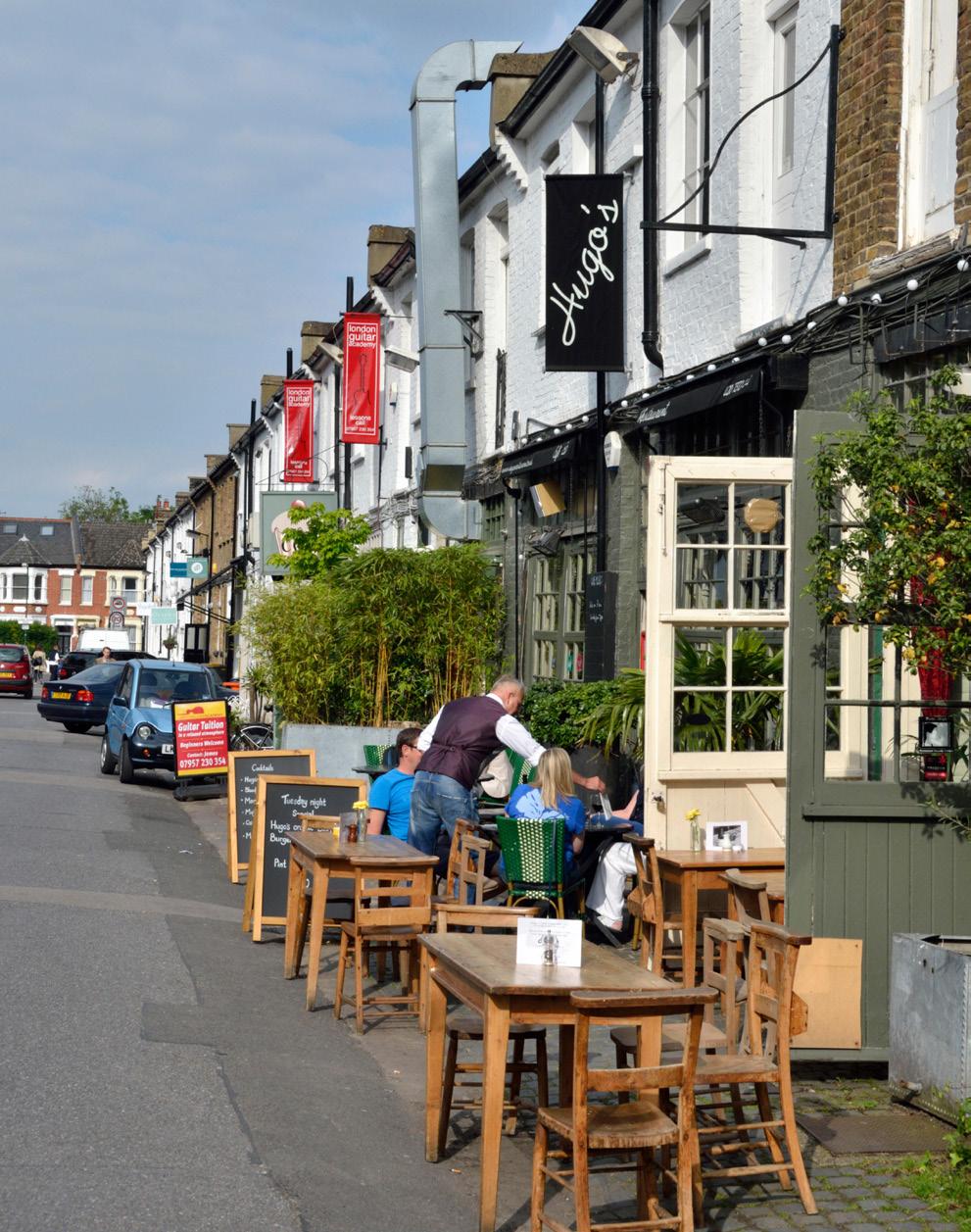
improvements and retrofits to minor alterations and changes of use. Our work has helped bring businesses such as Carmel, Don’t Tell Dad, Pizza Pilgrims, Wolfpack Brewery and more to the street. Each application may have been relatively modest in scope, but they are incredibly meaningful in their cumulative impact. Together, these interventions have elevated the street’s identity and activity levels without altering its fabric wholesale. This body of work demonstrates that placemaking is not reliant on one-off transformations, but can be achieved through a targeted, thoughtful build-up of improvements over time.
Lonsdale Road stands as a case study in how strong relationships, clear and aligned values, and sustained engagement can unlock transformation. The result is a vibrant, mixed-use street that has grown organically while remaining contextually grounded. Our long-term partnership with Akoya proves that meaningful change can be delivered, not in one bold gesture, but in modest, intentional steps.
by Sian Buckley, Consultant, Engagement

Built in 1966, Heston Grange is a post-war concrete-frame estate consisting of six staggered terraces, with 110 socially rented flats and 13 socially rented houses. Located in the London Borough of Hounslow, the estate is home to a vibrant and diverse community.
In 2023, Metropolitan Thames Valley Housing Association (MTVH), who own and manage the estate, appointed Iceni Engagement to work with residents to understand their views on the future of Heston Grange.
We began our community engagement in October 2023, knocking on residents’ doors and inviting them to complete a survey about housing conditions and their experiences. Drop-in events provided additional opportunities for residents to share their ideas and any concerns about their homes.
Based on feedback received in these initial engagement stages, we then organised an intensive series of consultation events to look at options for change. Oneto-one conversations gave us a real understanding of the challenges and opportunities faced by residents on the estate. The events programme included pop-up events with a coffee van and a community day which provided a forum where residents’ voices could be listened to. We also organised coach trip for residents to visit a recently completed MTVH scheme, Clapham Park, providing firsthand insight into what regeneration could achieve.
After a year of engagement activity, we drafted and distributed a Landlord Offer based on feedback, setting out MTVH’s commitments to residents should they vote in favour of redevelopment. Residents were then able to vote on what they wanted for the future of Heston Grange, with an independent ballot company brought in to oversee the voting process. We were delighted when 72% of residents voted in favour of redevelopment, from a 79% voter turnout. The regeneration of the estate will see it remain as 100% affordable housing, with every resident who wants to stay being able to live at Heston Grange following the regeneration.
Following the positive ballot outcome, Iceni has continued to work with residents and architects to shape the design of the new Heston Grange. Engagement efforts have included landscape workshops, public consultations, and collaborative workshops on detailed design elements to ensure the new development meets the needs of the existing community.
We worked closely with the architects, HTA, who created giant models of potential floor plans and interior designs to summer fun days, whilst we provided an ice cream van and bouncy castle for the younger Heston Grange residents.
Hosting interactive activities to enable residents to choose building materials and exterior layouts helped


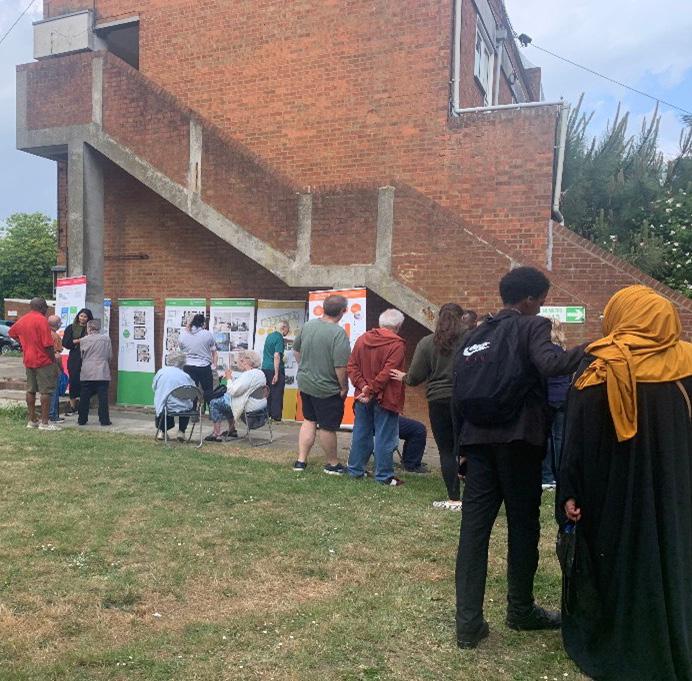
residents to stay engaged and shape the designs for their new homes. Throughout the entire process, Iceni maintained consistent communication lines with residents, including regular updates via the Heston Grange website, newsletters, and direct phone calls to ensure everyone remained informed and engaged in shaping the future of their estate.
We believe our consistent approach to engagement is ultimately what led to the resultant high level of resident participation, while working with MTVH and
the wider project team has been a positive experience for us all – with residents seeing the ultimate benefit.
MTVH intend to submit the planning application for Heston Grange to the London Borough of Hounslow in autumn 2025 and we are looking forward to seeing how the project progresses.
by Clive Burbridge, Director, Transport
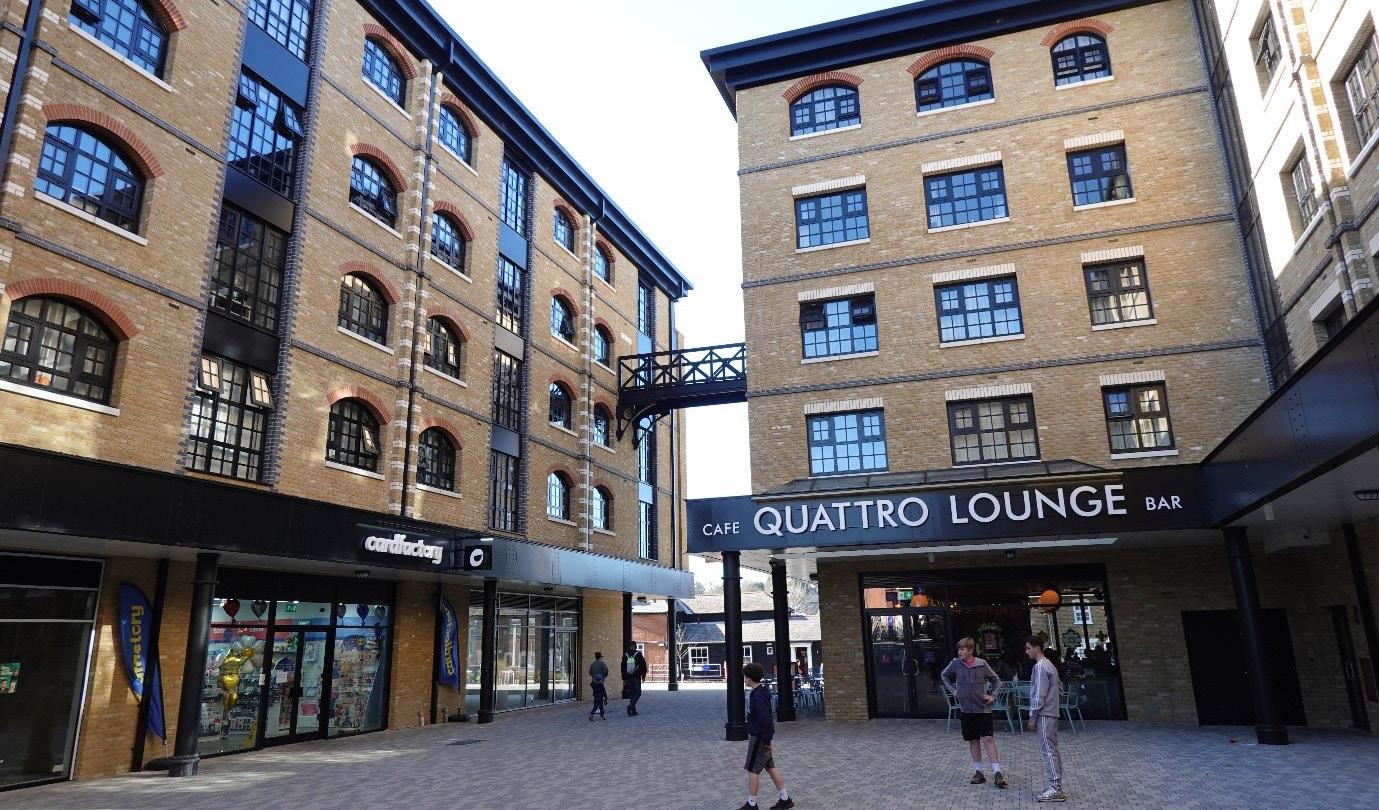
Back in 2014, Iceni began work on the proposals for a mixed-use redevelopment of an existing Bircherley Green Shopping Centre in the centre of Hertford, to provide retail units, a hotel and flats, on behalf of Diageo Pension Trust Ltd and in collaboration with Wrenbridge.
The site is located within Hertford Town Centre covering 1.02 hectares between Railway Street to the south, the River Lea to the north, Bircherley Street to the east and Bull Plain to the west, with good access to local bus and rail facilities.
The development comprised 4,694m2 of retail floorspace (Use Classes A1 to A5 at the time), an 86-bed hotel and 70 flats, and included the refurbishment of the existing car park in addition to enhancing the bus station and creating new public realm.
Permission was granted in 2018, and the site was sold to Chase New Homes. A revised application was submitted for 3,685m2 of commercial floorspace (including retail/restaurant units of circa 2,745m2 and NHS Walk in Surgery of 940m2 floorspace),
98 residential units and the retention of six existing bus stops at the bus station with Iceni retained as the transport consultant. In 2021 the revised scheme was approved and work started on site in 2022.
The scheme has now been built and is a pleasure to walk around, admiring the care and consideration which has gone into this application. It has transformed the rundown early 80’s shopping centre which turned its back on the water course into a modern, open design, with placemaking and architectural detail at its heart, with cafes and bars to bring life to the river frontage.
I still have to remind myself that these buildings have not stood there since the 1800’s; a true testament to the architect’s design. You cannot help but feel you are alongside an original wharf warehouse, like Ivory House, St Katherines Dock in London or the Albert Docks in Liverpool. No longer are the delivery and back of house functions overshadowing the water frontage, but you can now sit there and enjoy a coffee. I hope you will find the time to visit and admire what can be achieved with a good team and a client who is committed to deliver the finer details.
by Bronte Popplewell, Senior EIA Consultant

As part of our ongoing work in the City of London, in spring last year Iceni provided EIA and Socio-Economic services to Parkhurst Road Limited, on a site on the North Greenwich Peninsula - an area recognised for its redevelopment and evolving skyline of large, high-rise developments. The vacant former lorry park will be transformed into a mixed-use, student-led development with 352 residential dwellings and 340 student accommodation units along with commercial and amenity uses, set across buildings from nine to twenty storeys high.
The size and height of this development in central London, combined with several environmental sensitivities presented multiple technical challenges which our EIA and Socio-Economic teams helped navigate. Firstly, working alongside three architects and two planners, in addition to coordinating a nine technical topic Environmental Statement (ES) presented challenges in communication and coordination. As EIA coordinators, it was our responsibility to ensure continuity across the
technical disciplines and to ensure our deliverables were consistently met. Secondly, the built-up and constantly evolving nature of the Greenwich Peninsular, including the forthcoming development of the Knight Dragon development meant assessing cumulative impacts was a key part of the ES. Additionally, nearby surrounding features such as a night club known as Studio 338, and busy roads (i.e. the A102) contributed to noise impacts that influenced the site’s layout. Thirdly, the height of the development ranging between nine and twenty-six storeys presented daylight / sunlight and wind microclimate impacts which played a role in influencing design.
Despite the complexities this project presented, the full planning application was successfully submitted to the Royal Borough of Greenwich in March 2024 and received planning permission in September. Our EIA experience within the centre of London on large scale, mixed-use developments continues to grow, as demonstrated by a recent submission for a similar EIA scheme in Lewisham, and we are looking forward to working on more in the year ahead.
by Nick Walker, Director, Built Heritage and Townscape

It really doesn’t seem like more than yesterday that I was in a ‘club’ in a disused space in King Cross. Back in the early nineties this was an overlooked part of central London, but a number of old sheds and buildings did undergo repurposing for the odd one-off event.
Roll forward 30 years and you might think you would be hard pressed to find empty space in London, but industries, commerce and tastes all change, so there will always be meanwhile spaces left to occupy. One thing is for sure though, you might be hard pressed to find somewhere to go out clubbing!
In the post-pandemic world, working from home has had an enormous effect on commercial space, internet shopping has had a profound effect on the high street, and generational changes mean that bars and clubs are closing as young people hit the gym and meet each other online in the first instance when it comes to dating.
In my own fair city of Glasgow, the statistics on empty commercial buildings in the city centre are jaw dropping. According to Savills Glasgow Occupational Office Data Report for the first half of 2025, the overall vacancy rate for office space in the city centre sits at 15%, amounting to approximately 2.2 million sqft of empty space. There is high demand for Grade A office space, which is in limited supply, but until other buildings are retrofitted to Grade A equivalent, or
replaced with new build Grade A office space, they will remain empty.
So, what is ‘meanwhile space’ and why has it become such an interesting temporary development opportunity? In its simplest form, meanwhile space can be defined as ‘The temporary activation of otherwise vacant place, either internal or external.’ Temporary activation can offer a dynamic alternative to empty buildings and a chance for experimentation. With clever thinking, space can be put to use for other purposes until it can be brought into its long-term intended use. It’s about unlocking the potential of empty space to bring social, economic, creative, and cultural benefits to our city centres, for a few months or a few years.
Councils across the UK are increasingly supportive of meanwhile spaces as they can help to revitalise high streets, reduce vandalism, prohibit anti-social behaviour associated with vacant properties, and test new ideas for urban development without long-term commitment.
In the current economic climate there is no funding for the arts, but there is plenty of empty space in our cities, and for owners and developers looking for ways to invigorate their assets, allowing meanwhile use seems like a no brainer which could bring a cultural and creative buzz to empty buildings. Meanwhile use enables buildings to be occupied and business rates reduced, enabling spaces to have a life and be

“Councils across the UK are increasingly supportive of meanwhile spaces as they can help to revitalise high streets, reduce vandalism, prohibit anti-social behaviour associated with vacant properties, and test new ideas for urban development without long-term commitment.”
looked after until they are redeveloped and returned to conventional use. Whilst this is a temporary solution to more fundamental and systemic issues, it nevertheless breathes life back into our cities and encourages creative thinking about space.
When Marks and Spencer closed their Sauchiehall Street store in Glasgow, the building could have remained empty whilst the site awaited redevelopment for student accommodation, but Scottish organisation Outer Spaces worked with the landlord to fill the space with over ninety artists, writers, curators and performers, who used the vast floors for research, production, and presentation for over a year. At the end of their
tenure, the artists put on an exhibition of their work and hundreds of Glaswegians were given the opportunity to revisit an ‘old friend,’ creating considerable goodwill in advance of the redevelopment, which is now underway.
In London, Hypha Studio’s mission is to ‘open up empty high street and commercial spaces and offer them to artists to use for free following a free-to-apply open call for each space.’ Most notably, the organisation has recently clinched temporary exhibition space in the City of London at Michael Wilford’s seminal post-modern building, No 1 Poultry, whilst this undergoes an extensive retrofit and refurbishment over the next few years.
On 9th September, a ‘lively salon-style gathering’ entitled ‘Can Meanwhile Spaces save our nightlife?’ will take place at the Roca Gallery in London, to mark the end of their Meanwhile Space exhibition. According to Roca’s website, they will ‘gather together a cast of stakeholders including property developers, architects, performers and other vital stakeholders to reflect on meanwhile projects and argue the case for and against Meanwhile Space’s role in keeping live music and other night-time entertainment relevant, accessible and affordable.’ Perhaps my clubbing days are not over after all!
by Ashleigh Bullough, Associate Director, Planning

We are proud to be working alongside Vistry Partnerships to help them gain the planning permissions needed to deliver a significant number of homes in the London Borough of Enfield.
Vistry have been working in Enfield for a long time, and have now become the Borough’s largest housing delivery partner, working alongside the Council to deliver much needed affordable housing for them and other affordable housing providers.
The Iceni Planning Team are currently working with Vistry on three projects in Enfield: Meridian One, the Alma Estate, and North Middlesex University Hospital. All three projects combined have the potential to deliver around 2,400 homes. In all cases, the projects turn underutilised brownfield land, or housing estates in need of improvement, into muchneeded homes, with a significant proportion of affordable housing.
While working with Vistry on these projects, it has been clear to see their commitment to the Enfield area and their desire to deliver genuinely high-quality, sustainable and affordable new homes.
Key themes which run across each project and will ensure high-quality homes can be created, include:
A commitment to increasing public realm and greening – Vistry understands the genuine scheme benefits of delivering high-quality green and public spaces, including play spaces and new routes. On the Alma Estate, the latest permission on the final phases involves the creation of a new green street, residential courtyards, and play spaces. The green street was particularly welcomed by the Council as it helps to resolve local issues with cars using certain routes as rat runs, by changing one of the streets from a vehicle thoroughfare to a street primarily for pedestrian use. This has offered up significant opportunities to increase the number of trees and green landscaping, include interesting elements of play, and bring sustainability benefits.

•A clear understanding of how to deliver – what sets Vistry apart from many others is that they are fully committed to delivering the housing they get permission for. They have a strong track record and understand delivery challenges well, so lessons learnt from the delivery of earlier phases or previous local schemes can be fed into the design and phasing of these new schemes. This includes reflecting on details such as choice of materials, flat layouts and access to communal facilities at an early stage in the process to ensure new homes are always improving in quality.
On Meridian One, we are currently engaging with the Council on proposed changes to the materiality of one of the blocks to ensure the building is completed with a robust, high-quality design, that will last its lifetime.
A commitment to the local community – Vistry genuinely want to understand the needs of the local community and ensure projects can benefit them. This is demonstrated by their commitment to the delivery of right type and size of affordable housing. On all their projects, Vistry always has a very clear understanding
of the local population and the type of affordable housing that is required, so the housing mix proposed genuinely reflects this need. Vistry projects also tend to involve some element of community floorspace.
On the Alma Estate a new higher quality community centre and health centre was provided, while at North Middlesex University Hospital, the intention is to provide a new nursery to serve both new residents and the existing community.
Working on these projects alongside Vistry has allowed us to build strong working relationships with the client team while establishing an excellent knowledge of their business model and priorities. Working on these three projects in Enfieldhas also allowed us to strengthen our relationship with the Enfield planning and design teams.
We look forward to continuing to work with both Vistry and Enfield to ensure the high quality affordable housing the community needs can be delivered.
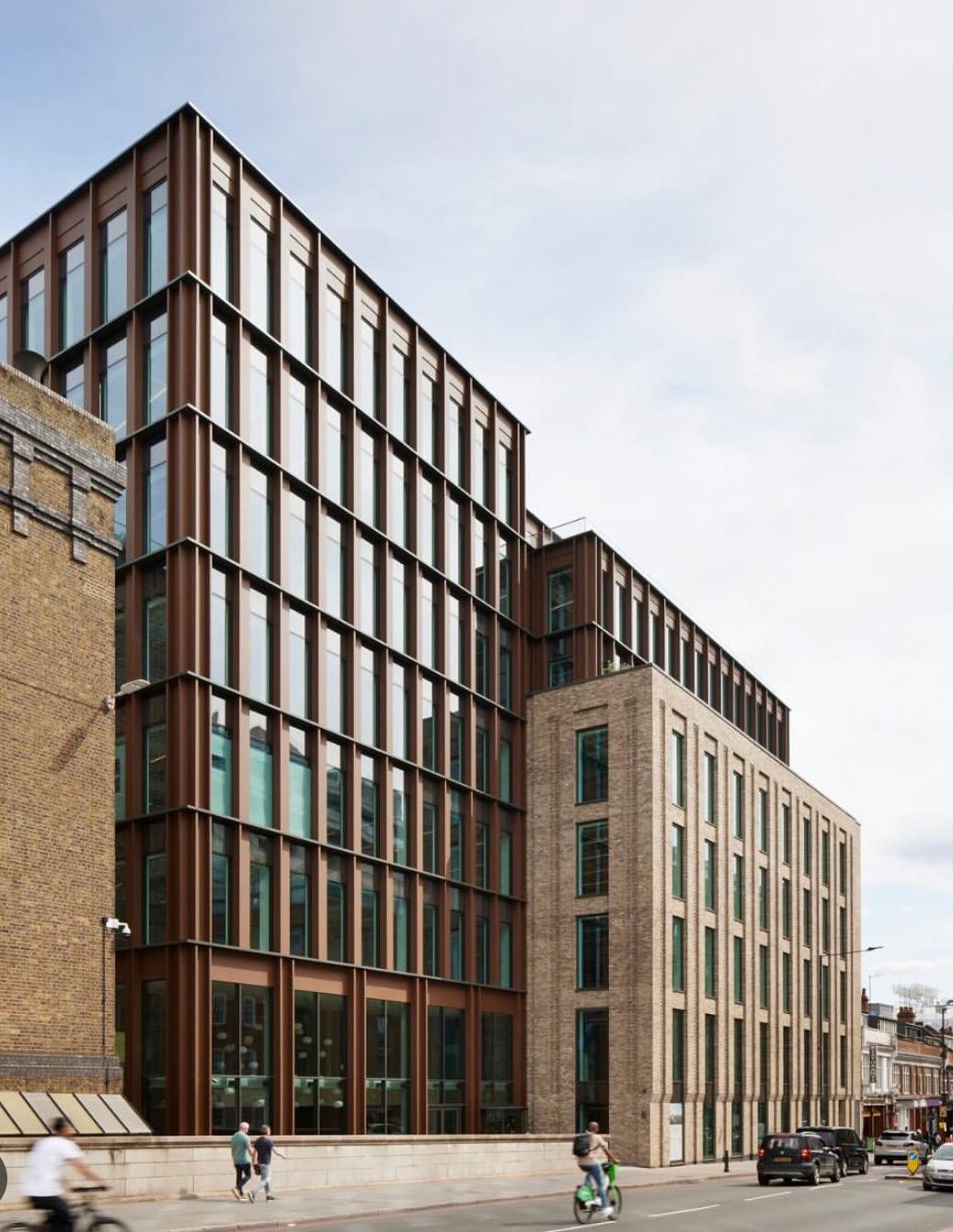
by Will Clutton, Associate, Planning
In July, we were delighted to be invited to the opening of TBC.London, a new commercial development on Tower Bridge Road in the London Borough of Southwark. The event celebrated the practical completion of an exciting scheme in a very unique location and the culmination of over seven years of hard work from the project team.
The previous building at Tower Bridge Court was something of an anomaly – a very ordinary building in an extraordinary location, a tired old office block situated in fashionable Shad Thames and directly adjacent to Tower Bridge, on one of the most prestigious sites in London.
Since 2018, the Iceni Planning Team have been advising our client Fore Partnerships to help them realise their vision. The plans will provide 110000 sqft Category A Office floorspace at upper levels, with flexible floorspace at ground and first floor levels to be occupied by a renowned Food Hall operator, and a separate space for local community groups to use. Planning permission was granted by the London Borough of Southwark in 2020 for a sensitive retrofit and extension of the existing office building, designed by Stiff and Trevillion Architects, to deliver a highquality modern commercial building with impeccable sustainability credentials, as one of London’s first net zero workspaces. Iceni have subsequently worked with Fore and their contractors, Willmott Dixon, to manage planning matters on the scheme throughout the implementation and construction phases.
Of course, sites of such sensitivity do not come without their planning challenges - even following the grant of
planning permission. The historic location and tightknit residential surroundings presented numerous considerations during the detailed design and construction phases. The post-submission programme incorporated six amendment applications and an extensive conditions discharge programme, including detailed negotiations with Officers and Members on matters of heritage, transport and amenity impacts relating to the incoming food hall operation.
Having navigated these challenges though collaboration with an excellent project team - including Iceni’s Heritage and Townscape and Transport Teams - and a knowledgeable and proactive team of officers at the Council, we were able to conclude all planning matters in time for the opening celebrations. As such, we were able to enjoy what must be, pound-for-pound, one of the best rooftop views in the City – just look at the images and judge for yourself! If you are in the Shad Thames Area any time soon – do drop by and pay a visit.
by Nick Grant, Director, Planning
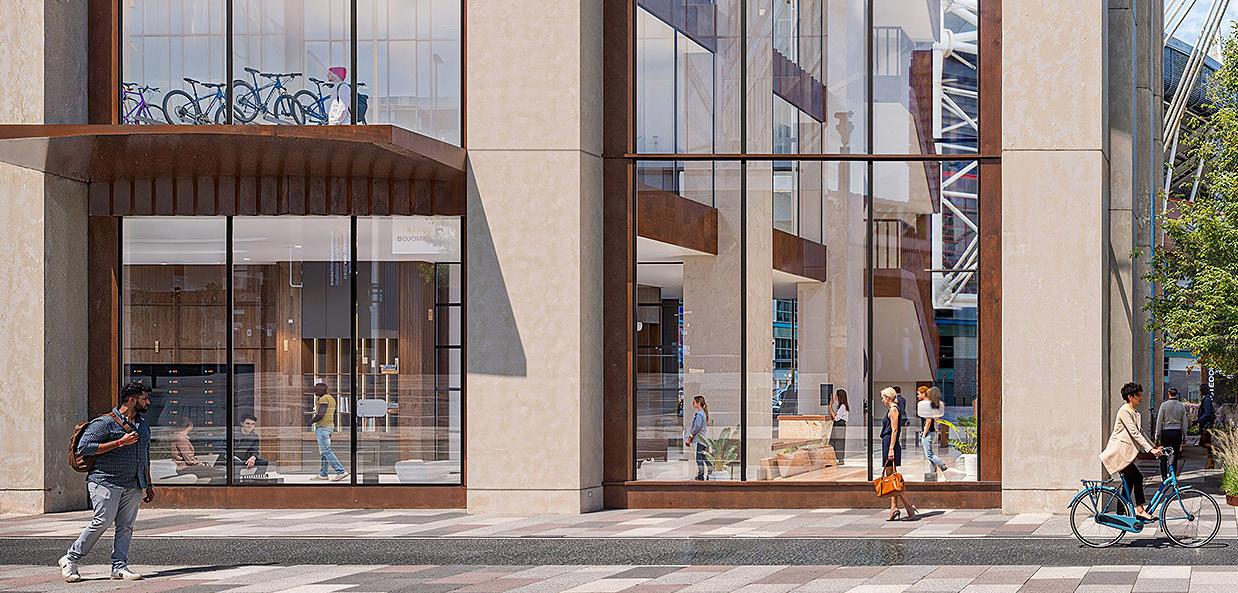
Well, what another roller coaster of a year that has been! And we’ve loved every moment of it.
Bluecastle Capital are quietly become one of the most watched newcomers in the build-to-rent (‘BTR’) scene, steadily amassing an impressive development pipeline across the UK. In what is a crowded market, Bluecastle are seeking to stand out from the crowd with a distinctive, investor-focused approach to large-scale rental housing. In little more than two years Bluecastle have assembled a number of high-profile city centre sites - and they want more. From Stevenage and Sheffield, to Cardiff and Birmingham, their portfolio is growing and amounts to 1,500+ homes and a clear intent to scale rapidly in the institutional BTR market.
A key part of Bluecastle’s momentum comes from their disciplined capital strategy and bold public positioning. The business wants to accelerate acquisitions and development at pace, focusing on delivering operationally ready rental assets for longterm investors. The end product is fundamental to everything Bluecastle do, with a particular focus on amenity space and aspirations to set new standards for the market.
From a town planning perspective, our discussions with councils as part of the planning process has been extremely positive and well received. Bluecastle’s approach to quality, attention to detail and delivery
create the perfect platform for achieving the best outcomes for all stakeholders.
Looking at the sites in more detail starts to paint a picture of the direction Bluecastle are going in….
In Stevenage, Iceni are currently finalising the S106 for a major new mixed-use development in the town centre. Being less than a 5 minute walk to the main station and a 20 minute train ride to Kings Cross, the site represents a prime opportunity to bring forward a significant BTR development in the heart of Stevenage. The site occupies a strategically important and prominent position within the town centre, which through a wave of new development, is being transformed from a tired new town into thriving new mixed use community. At 21 storeys, the development will be the tallest building in Stevenage town centre and will deliver exceptional design quality.
In Sheffield, we are finalising the S106 (via a delegated decision) for the redevelopment of a prominent site that sits on the edge of the city centre ring road. The site is at the gateway to the Sheffield Midland Station and Sheaf Valley regeneration area – a transformational regeneration opportunity being brought forward by the Council to drive sustainable development and inclusive growth. Bluecastle’s 26 storey-high development will deliver 413 homes and will be one of the tallest buildings in Sheffield, providing a new landmark building in this


gateway location. Sustainability and green credentials are at the heart of the design approach, and the new buildings will be set around extensive landscaping and greening at ground and upper levels, transforming this long-term derelict site.
In Cardiff, Bluecastle acquired the most prominent site in the city, immediately adjacent to the iconic
Principality Stadium, and at the heart of the Council’s city centre regeneration plans. In September, following extensive pre-application consultation with the Council and wider stakeholders, Iceni submitted a planning application for a 50 storey building that will deliver 528 new homes and a pavilion building within a new public square. The tower will be the tallest in Wales and will deliver an iconic new landmark for the city that can act as a catalyst for future investment while reinforcing Cardiff’s status as an internationally important city.
In Birmingham, Bluecastle’s acquisition of the former Marks & Spencer flagship store on the High Street is potentially the most exciting site yet. The site is immediately adjacent to the new Curzon Street HS2 terminus and will be the ‘front door’ to the city centre. Following initial positive discussions with the Council, we are right at the start of the planning journey. The site is one of the most strategically important in Birmingham and has the potential to deliver significant placemaking interventions that will make a key contribution towards the Council’s ambitious ‘Park Birmingham’ vision. Given the location, there is also the potential for a landmark building that can truly signify Birmingham’s status on the world stage.
So what’s next? Bluecastle’s ambition does not stop there, and Iceni are advising on a variety of other potential new sites across the country. Watch this space…
by Paul McColgan, Director, Economics

Since the start of 2024, only 25 local authorities in England have successfully adopted a new Local Plan, with Iceni’s Economics team supporting around one quarter of these through examination.
The examination process can be combative but is often enjoyable and occasionally rewarding when all the years of detailed evidence and analysis come to fruition. Examinations are also a good opportunity to get out of the office for a few days, even if the destinations are not always exotic.
One examination venue which was more interesting than most, was York Racecourse, where hearings commenced for the City of York’s Local Plan Examination way back in December 2019, just two days before a general election.
After five separate hearing sessions, one pandemic, two monarchs, four prime ministers and countless housing
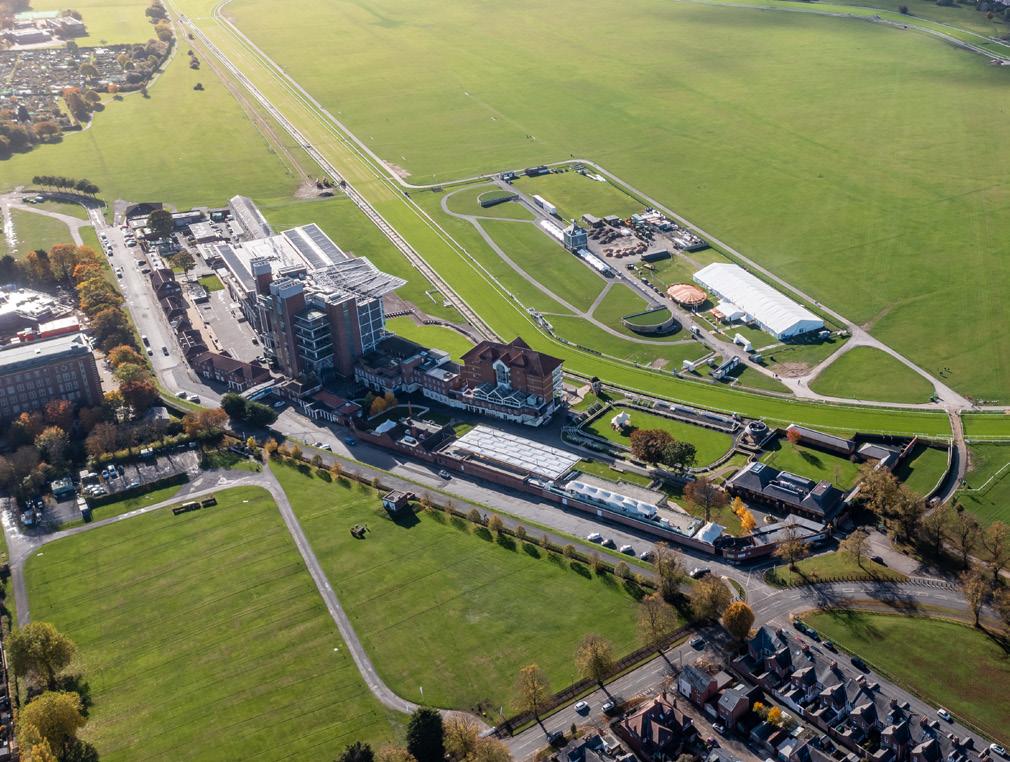
ministers, the City Council finally adopted its Local Plan in February 2025. However, what makes this one so remarkable is the fact that it is the City’s first Local Plan since 1956.
In successfully supporting the Council to adoption, our team had to navigate a rapidly changing economic and planning policy landscape, including

the introduction of the standard method and its alignment with economic growth. The inspectors concluded that the Council’s approach to economicled housing need was both ambitious and justified despite the economic uncertainty at the time.
Another rewarding Local Plan examination was in Bassetlaw, when the Council was chasing success with the inspector while England sought to end 56 years of hurt at the 2022 World Cup in Qatar (spoiler alert, the hurt goes on).
We had spent much of 2022 and the previous year producing an evidence base which reflected Bassetlaw’s unique opportunity to capitalise on its strategic location on the M1 and A1 and its surplus of brownfield land, a legacy of its mining heritage.
The main challenge, however, was to ensure that there were enough people to fill these additional jobs; and these people required homes. This required looking
into the scale of job opportunities across the Council’s strategic sites, taking into account leakage, substitution and displacement, alongside economic activity rates, double-jobbing and commuting ratios.
The result of this was a housing requirement significantly above the local housing need figure derived from the standard method, and after this was accepted by the inspector, the Council adopted its new Local Plan in May 2024.
However, the real reward came further down the line when the Council was given the Best Plan Award and named Planning Authority of the Year. The judges praised the Local Plan for its creativity, ambition, and for going above and beyond good practice to help deliver positive outcomes for local communities.
For us at Iceni, it has been rewarding to see years of evidence-based planning not only shape successful Local Plans but also deliver wider recognition.
by Grace Wileman, Associate, Iceni Futures

Following the launch of our inaugural Environmental, Social and Governance Strategy last year, the Iceni ESG Committee has published our strategy for 2025, providing an update on our work.
Our ESG Committee, which continues to build on the longstanding work of our Environment and Sustainability Committee that was first launched in 2018, comprises 12 dedicated members who meet regularly. Rebranded as the ESG Committee last year, our objective is to help the business lead the way in terms of environmental and social performance within the property industry.
Each year, we conduct an ESG survey to gather views across the company, and to inform our key targets for the year, which include:
Maintaining our carbon-neutral status
Greater consideration of our travel options
Increasing staff volunteering days

Hosting more charity events and seeking to increase our charitable contributions to £20,000
Continuing to support the Tribe through their professional chartership
Since the publication of our inaugural ESG Strategy last year, we have dramatically increased take-up of our Give a Day, Get a Day initiative (see additional articles in this section), led the company through a second Plastic Free July, and are continuing to support our graduate planners through their chartership journey with the RTPI.
But there is always more to do.
Achieving our goals means every individual across the whole company making small changes, so we will be carrying out our next annual survey soon to begin the process of co-designing new targets. By involving everyone in the process, we are taking them on the journey with us – which will be crucial to our success.
by James Bompas, Director, Business Development

Sri Lanka is a country I know well. My wife is Sri Lankan and we visit regularly.
Close to where we stay is Ladani, a small orphanage which is home to 23 young girls. The country is still recovering from its worst financial crisis in decades and poverty remains high at 24.5%. Many families survive on less than $3.65 a day with wages still below pre-crisis levels
In such a climate an orphanage’s needs are acute and ongoing.
Wanting to help in a way we could see and track, we organised a Sri Lankan themed evening in our office for colleagues to enjoy samosas, mangos, coconut water and a few Lion beers. The target was £250. Afterwards I posted the charity link on LinkedIn and the response was humbling. Clients, friends and councils contributed. Together we raised £1,500.
The funds provided a much-needed computer to support the girls’ education, groceries for several months, and medicines to improve their health.
When visiting Sri Lanka I delivered these in person. A grounding moment came when I set up the new Mac, a model we had managed to secure on pre-release arriving before any others in the country, and asked the girls to turn it on. Their caregiver quietly explained they were embarrassed. None of them had ever used a computer before, so they did not know how to turn it on.
That moment underlined the value of what we had done together. It is a gateway to opportunity. The food has given security for the coming months. The generosity shown will be felt long after the funds have been spent. Thank you to everyone who made it possible.
by Amy Foster, Senior Consultant, Economics

As part of Iceni’s ‘Give a Day, Get a Day’ initiative, the Economics Team recently spent a day volunteering with the Dons Local Action Group (DLAG) - a community of volunteers supporting those in severe financial hardship across South West London. The day gave us a valuable insight into the scale of DLAG work and the significant positive impact it has on local communities.
Founded in 2020 by three AFC Wimbledon fans as a response to the COVID-19 crisis, DLAG started with food collections for vulnerable and self-isolating residents and has since grown significantly, powered by a huge network of volunteers. Today, DLAG delivers over 400 food boxes a week to individuals and partner organisations across Merton, Wandsworth and Kingston.
Our day began at DLAG’s warehouse and distribution hub in Wimbledon - the heart of their operations. There, we rolled up our sleeves and helped sort
and pack food parcels for individuals and families in need. These aren’t just basic food packages – the first package includes a range of cooking and hygiene essentials, such as herbs, oils, shampoo, conditioner and handwash. Impressively, DLAG tailors boxes to meet a range of dietary requirements, including vegan, pescatarian, and halal - and even supplies food for pets where possible.
Some of our team joined delivery rounds, dropping off mattresses, microwaves and food parcels directly to those who are in need, including to a women’s refuge. It was incredibly impactful to be able to witness first-hand the direct impact that DLAG has on those they serve.
In the afternoon, we assisted with supermarket food collections, encouraging members of the public to donate priority items from an updated daily list of goods needed to keep the warehouse stocked. It was great to see strong support from local residents who generously donated.

What really stood out throughout the day was the dedication and passion of the DLAG staff and volunteers. DLAG’s network of over 3,000 volunteers come from a wide range of backgrounds and bring a huge amount of enthusiasm and resourcefulness to their roles. There were countless examples of volunteers going above and beyond to ensure that deliveries were made to those in need – seven days a week and 365 days a year.
We were also struck by the breadth of DLAG’s workwhile food parcels are central, they also distribute a wide range of other goods, including baby essentials such as nappies and formula, household furniture, digital devices to tackle digital exclusion as well as school uniforms, sports gear and musical equipment to help young people join in with activities.
The experience was a stark reminder of the economic and social inequality that exists within London and highlighted how vital charities like DLAG are in bridging the gap and supporting those who might otherwise fall through the cracks.
DLAG depends on the generosity of volunteers and is always looking for new supporters. Whether you can give an hour or a day, your time will make a real difference.
To learn more or get involved, visit: www.donslocalaction.org
by Silke Gruner, Director, Landscape

Iceni’s Landscape team is a little over three years old now. I had been a friend of Iceni for several years before I officially joined the tribe to set up the Landscape Team in June 2022, and when my colleague, Sam Griffiths, joined a couple of months later, he was intended to be my right-hand person. However, Sam was so well regarded within the Solar DCO world, that he quickly built up a client and project list to rival mine. It turned out he was going to be no help to me at all, and was instead spending his time leading and developing his own impressive portfolio of projects.
We needed help. It is notoriously difficult to find good landscape planners who can also design, but the Iceni team jumped on board and further recruitment was soon in full swing.
A little over three years later, and the Landscape team are now a lively bunch of 11 landscape architects, with two more landscape planners set to join us in October – a testament to the great working conditions at Iceni, alongside the lovely tribe members.
We are now working on a more diverse range of projects, from large-scale renewables projects, to single-dwellings. In fact, I wrote a landscape appraisal for a manhole cover this week (don’t ask), which just goes to show how widely our landscape inputs are appreciated and required. We have built up a loyal client base through our continued delivery of very high quality work, and we always ensure that our advice, plans, and reports are able to stand up to the rigours of Planning Appeals and Inquiries.
Our team nicknames, ‘Solar’ Sam and Silke ‘Grey Belt’ Gruner, give a flavour of the current focus of our work. However, we are so much more than that and refuse to be pigeonholed! Instead, our nicknames allude to the present needs of our clients within this current planning framework.
In the future, I hope to continue building the team, both in terms of new recruits, but also in terms of the skills and knowledge that we have, in order to continue giving our clients an A-class service. We will also remain one of the nicest and most fun landscape teams in the country, thanks to my team and the Iceni tribe.
by Seona Macbean, Assistant Planner, Scotland Planning
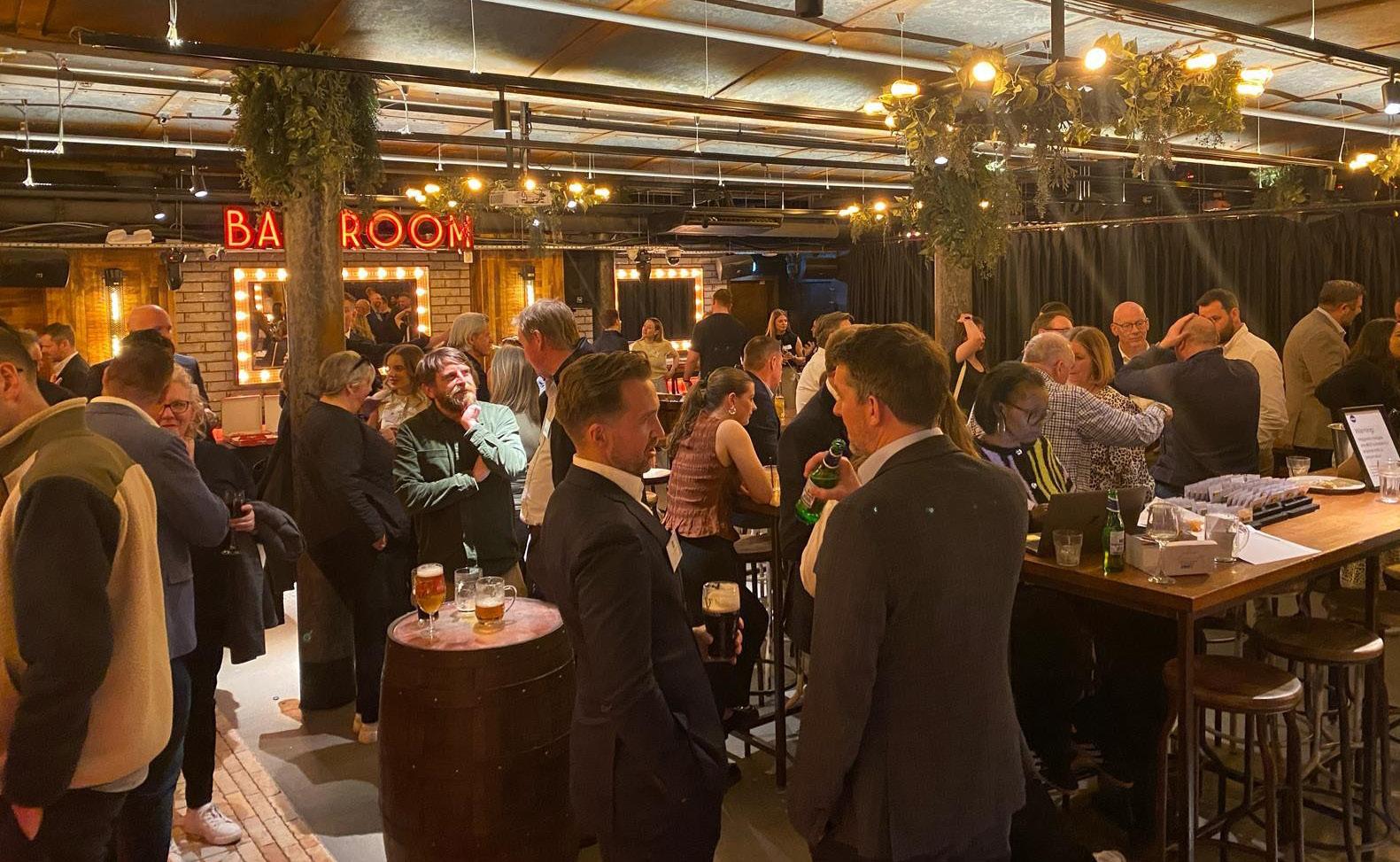
Iceni Scotland brought together clients, colleagues, and consultants for a lively evening at Wunderbar Glasgow in April. The event was both a chance to celebrate another successful year for the team and the first stop in Iceni’s nationwide and international 20th anniversary celebrations.
For Team Scotland, it was the perfect opportunity for us to look back on a busy and rewarding year with standout projects including:
National mixed-use development at Govan Graving Docks
Major PBSA and flatted development at 20 India Street, Glasgow
Major PBSA and BTR development at the site east of 16 Havannah Street, Glasgow
Major retail development at Smithton, Inverness
Major residential development at Inverlair Avenue, Glasgow
The night drew around 80 guests from a wide range of sectors. The strong turnout reflected both the collaborative nature of our work and the enthusiasm for in-person networking following the challenges of recent years.
Wunderbar — if you know, you know — provided the ideal backdrop for the evening, offering a relaxed, welcoming atmosphere where conversations flowed freely. . The informal setting encouraged meaningful networking, with attendees enjoying the chance to connect across teams and areas.
A highlight of the night was the appearance of a magician, who performed a range of close-up tricks for guests throughout the night. This entertainment added a playful twist to the evening and was an engaging icebreaker. The magic acts sparked conversations and united attendees across age groups and professional backgrounds.
All in all, the Spring Party was proof that business and celebration can go hand in hand. With the right mix of people, place, and a bit of magic, the night set a positive tone for Iceni’s anniversary year of celebrations.
by Jonathan Stewart, Director, Design
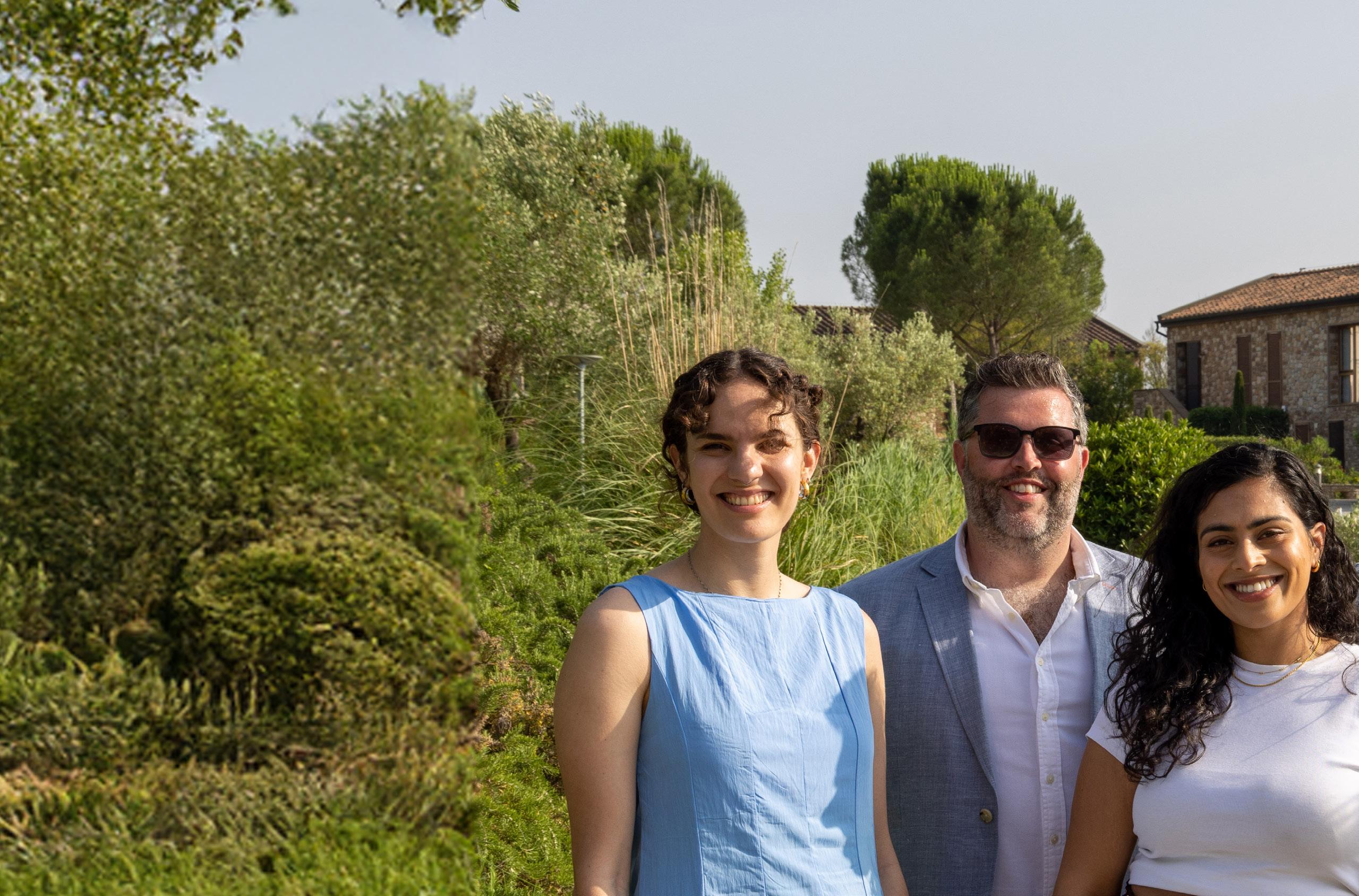
2025 has marked a significant period of transition and growth for Iceni’s Design team. We honoured the retirement of Paul Drew, whose leadership over many years established a strong platform of success. Building on this foundation, Jonathan Stewart joined as Director, supported by the existing talented team including Diego, Matias, Celia, and Harpriya. Together, they are driving the next phase of innovation and delivery of Iceni’s urban design and masterplanning offer.
This change in leadership coincided with a pivotal moment for the development sector. The Government’s revised National Planning Policy Framework (NPPF), including the reintroduction of mandatory housing targets and the reclassification of lower-quality Green Belt land as Grey Belt, has reshaped the planning landscape and consequently pushed strategic masterplanning into overdrive!
This resulting increase in demand for urban design and masterplanning services has enabled the Iceni Design team to strengthen its reputation for delivering highquality, client-focused solutions, while also reinforcing collaboration across the wider Iceni tribe. Our work this year reflects not only resilience during change, but also the ambition to lead in shaping places that meet the needs of communities and clients alike.
To date, we have submitted applications for almost 3,000 new homes including a new neighbourhood in Thurrock, Essex, advanced work on a further 5,500 currently in the pipeline including a new garden community in Kent, and secured consent for an additional 1,000, representing more than 9,000 homes in total. Together, these achievements reflect the breadth and depth of the team’s capabilities, from shaping strategic masterplans to supporting delivery on the ground. They also demonstrate the momentum we are building as demand for our expertise continues to grow, setting a strong platform for further success in the year ahead.
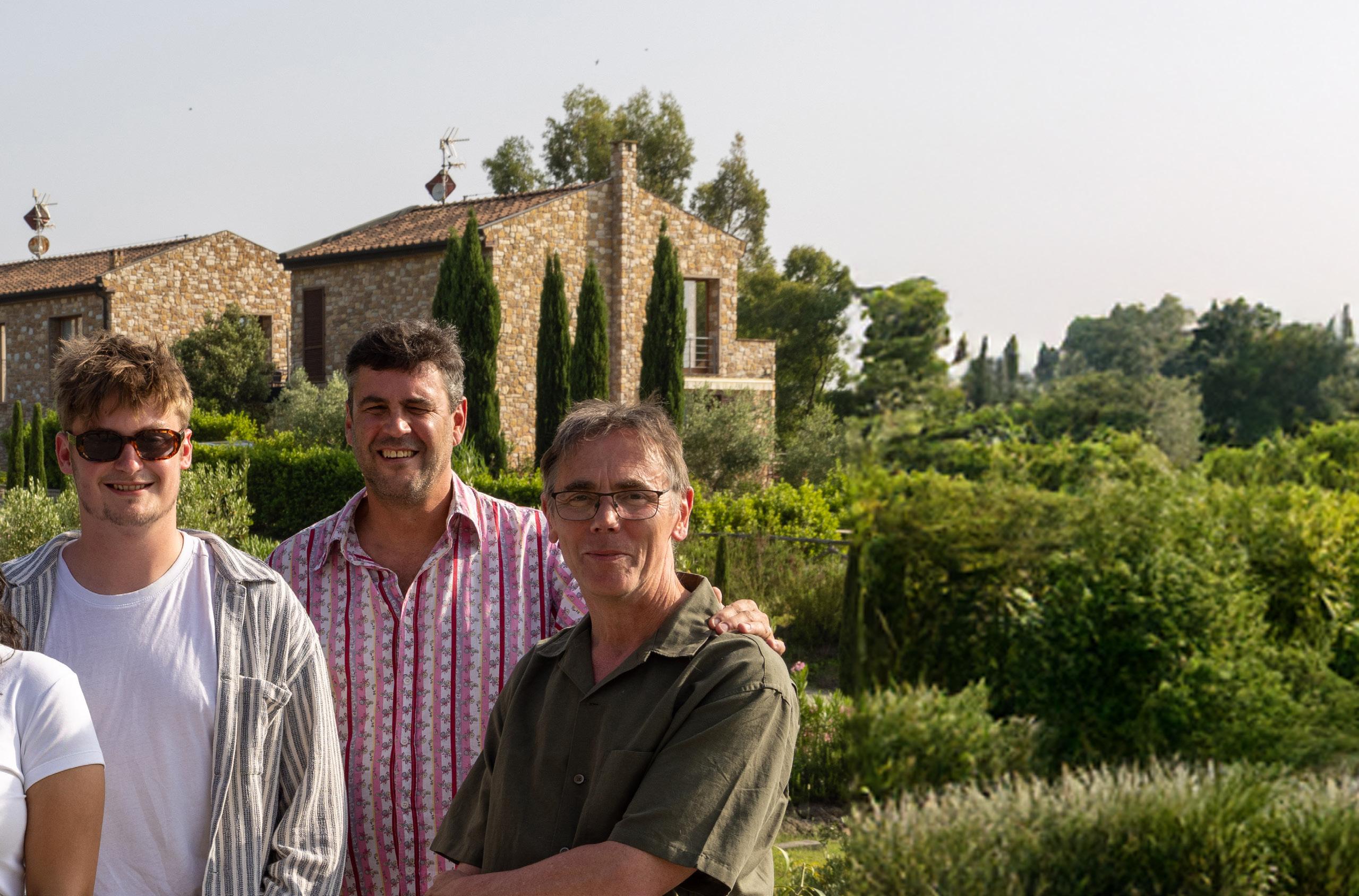
In response to this growing demand, we were delighted to welcome two new urban designers, Robbie Gibson and Matteo Atik, to the Design team. Their arrival has strengthened our expertise and brought fresh perspectives, marking an exciting stage in the team’s continued growth.
Robbie joined the tribe just in time to take part in Iceni’s 20th anniversary celebrations in Tuscany - a memorable start to his journey with us! Based in our Glasgow office, his arrival strengthens our design offer north of the border and further enhances our ability to provide a seamless, multi-disciplinary service across Iceni.
Over the summer, we also welcomed Matteo to the London team. Matteo adds specialist skills in 3D modelling (Rhino) and GIS, broadening and enriching our design capabilities. His expertise will be showcased in upcoming projects and, we hope, in next year’s Yearbook!
The arrival of Robbie and Matteo highlights both the continued growth of our Design team and the
momentum we are building as we broaden our offer. With seven members now forming a diverse and talented group, the team brings together a wide range of skills and experience to deliver for our clients. While strategic residential development remains at the core of our work, we are increasingly expanding our expertise into other sectors, including industrial and logistics, as well as renewable energy. This growing portfolio reflects the strength and adaptability of the team, reinforcing our ability to create value across an ever-wider spectrum of projects.
As we look ahead to 2026, we do so with confidence and ambition, committed to building on this momentum and continuing to deliver innovative, sustainable and impactful design solutions.
Birmingham: The Colmore Building, 20 Colmore Circus Queensway, Birmingham B4 6AT
Edinburgh: 14 -18 Hill Street, Edinburgh EH2 3JZ
Glasgow: 201 West George Street, Glasgow G2 2LW
London: Da Vinci House, 44 Saffron Hill, London EC1N 8FH
Manchester: WeWork, Dalton Place, 29 John Dalton Street, Manchester M2 6FW
www.iceniprojects.com iceni-projects iceniprojects